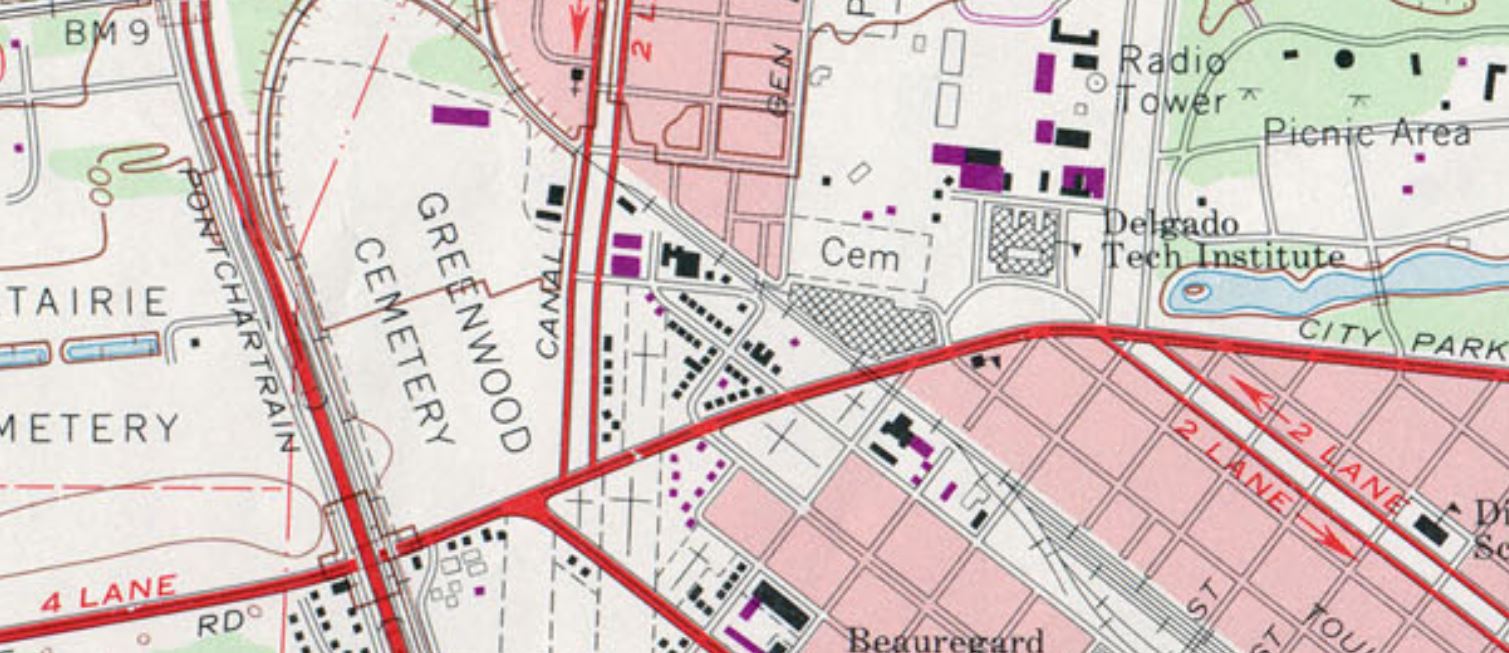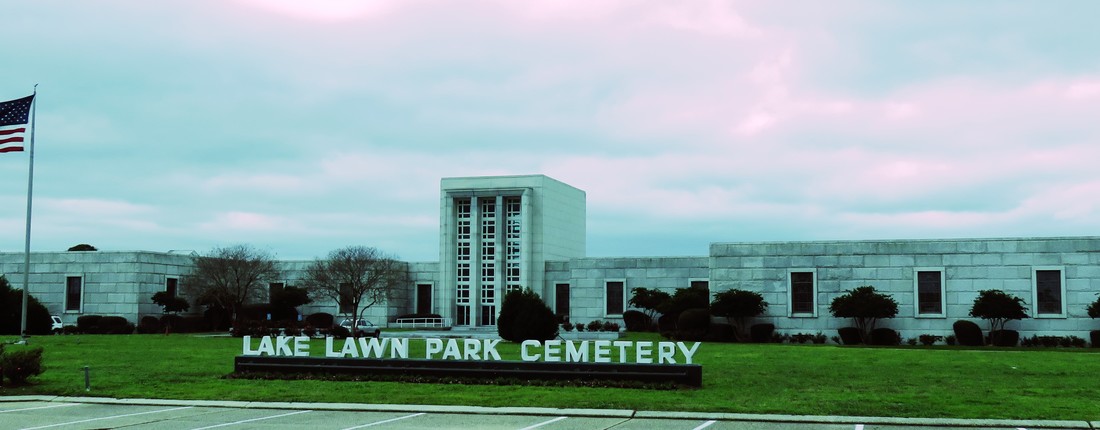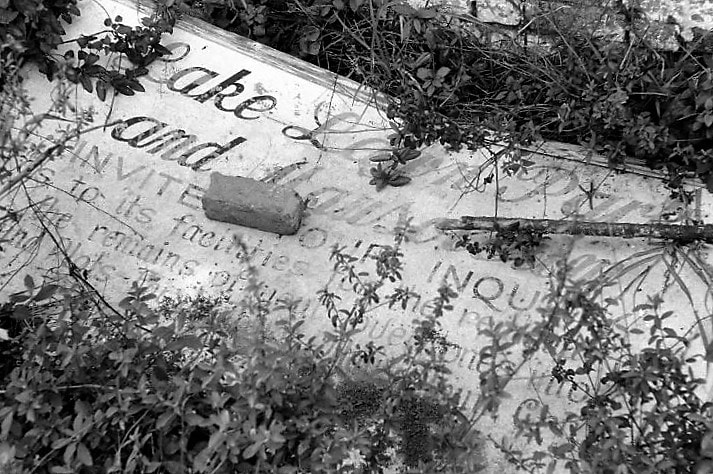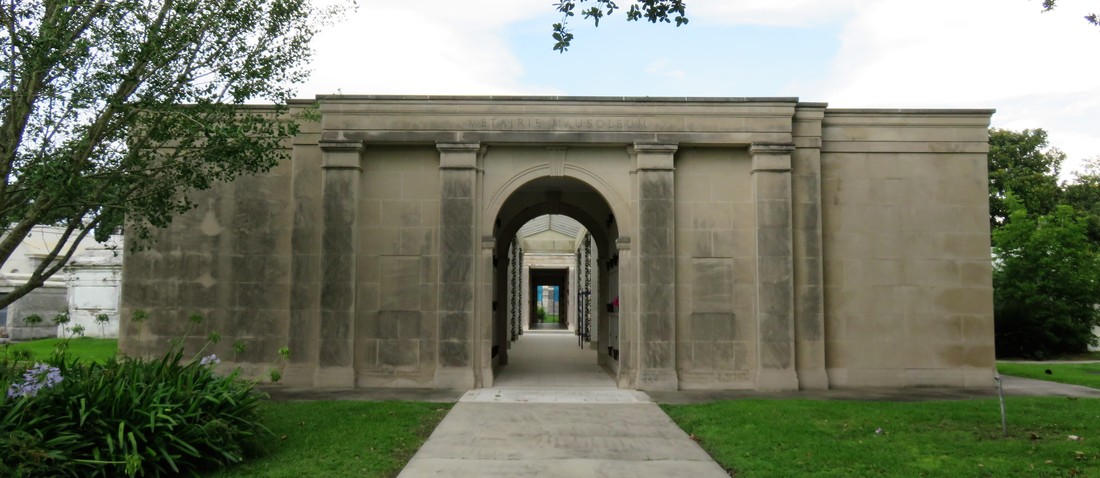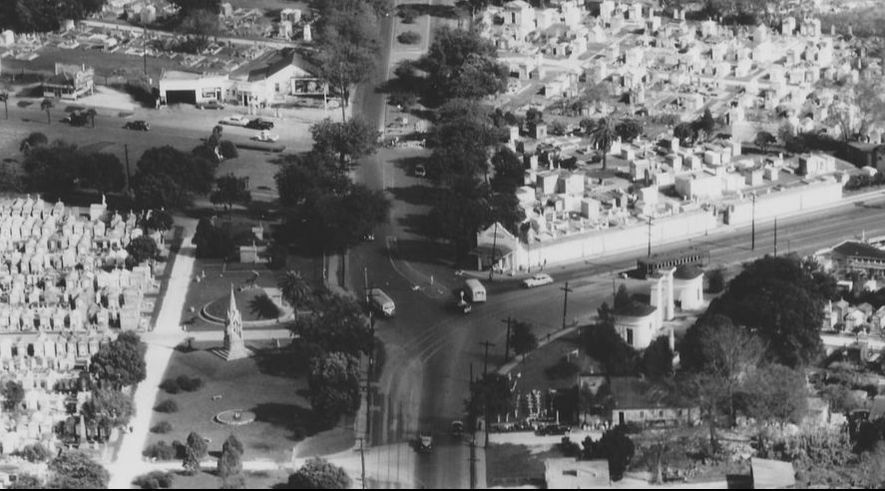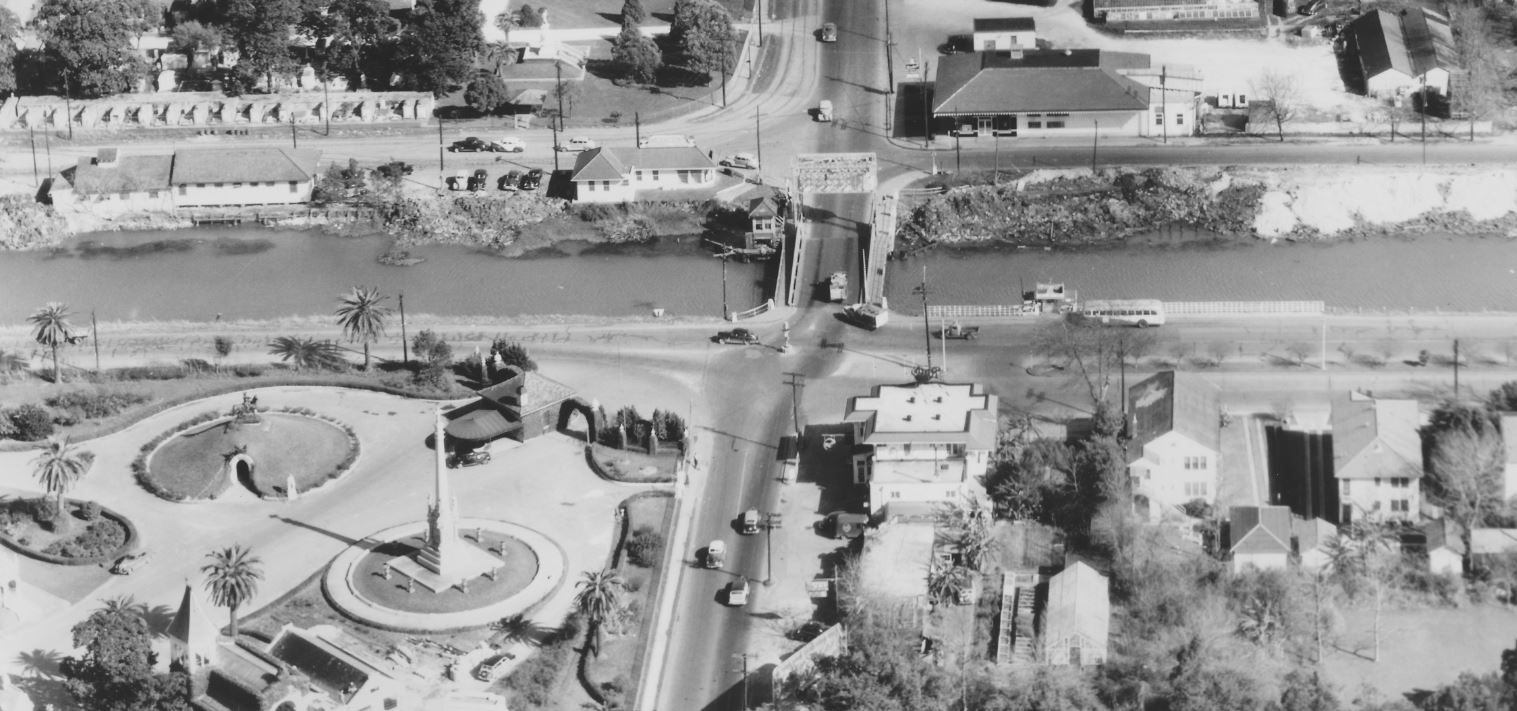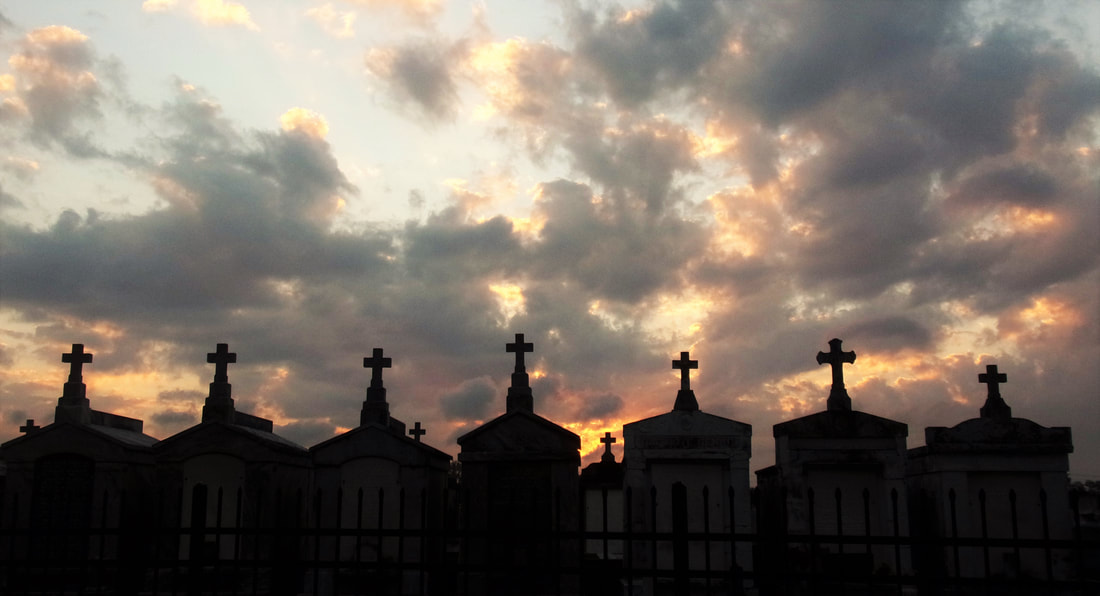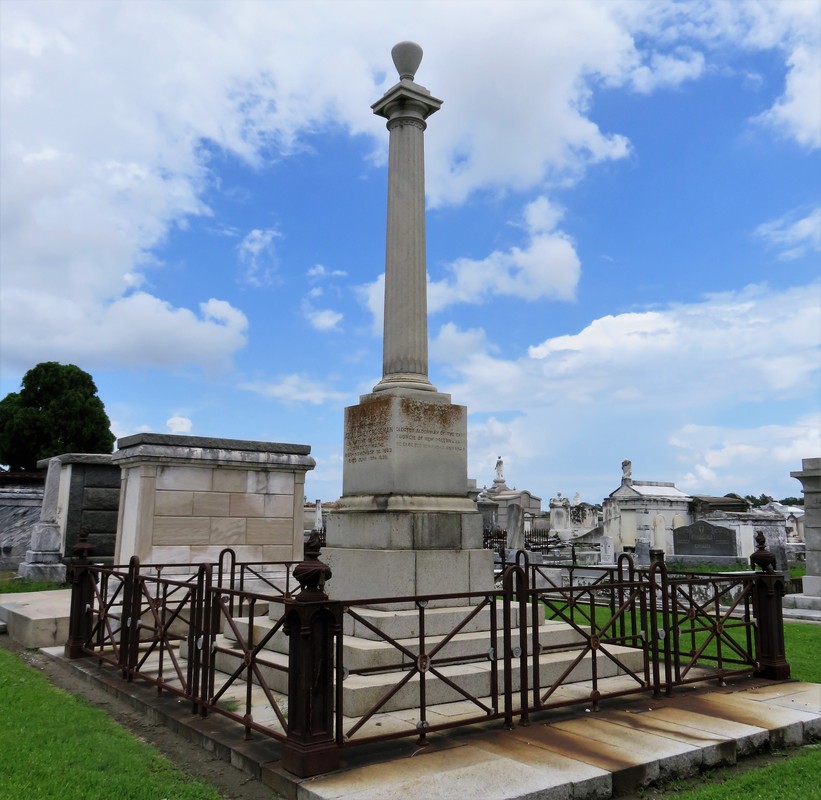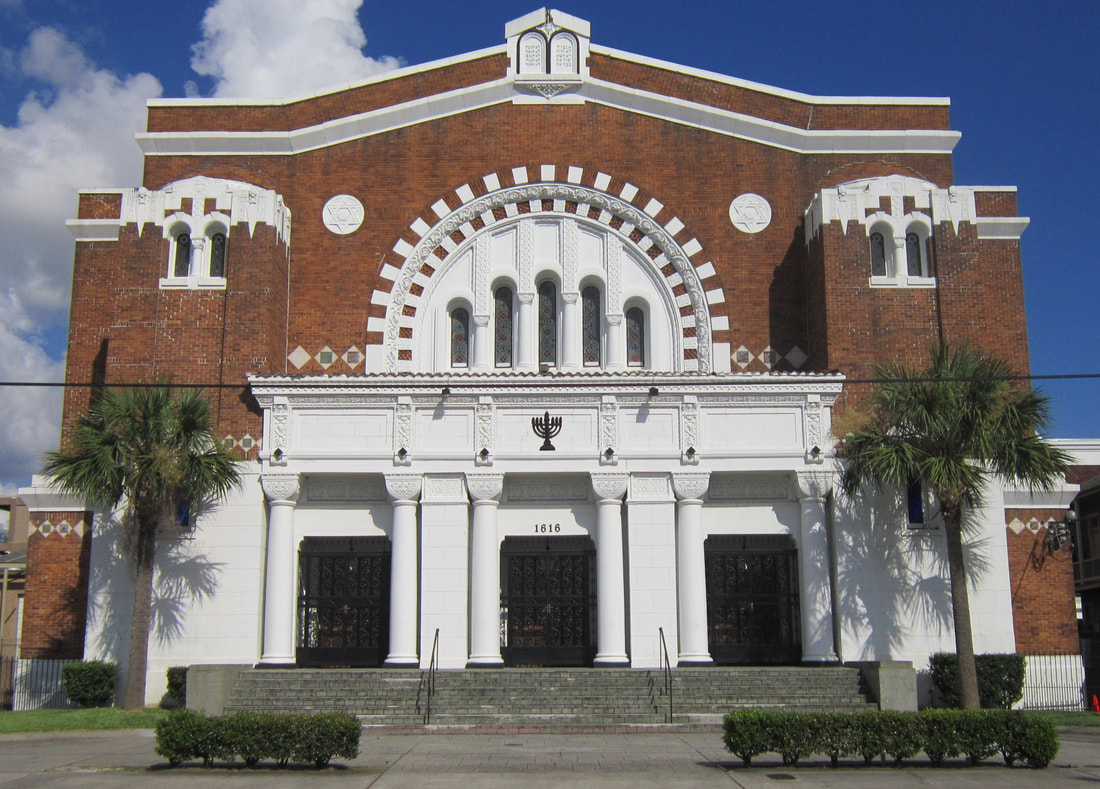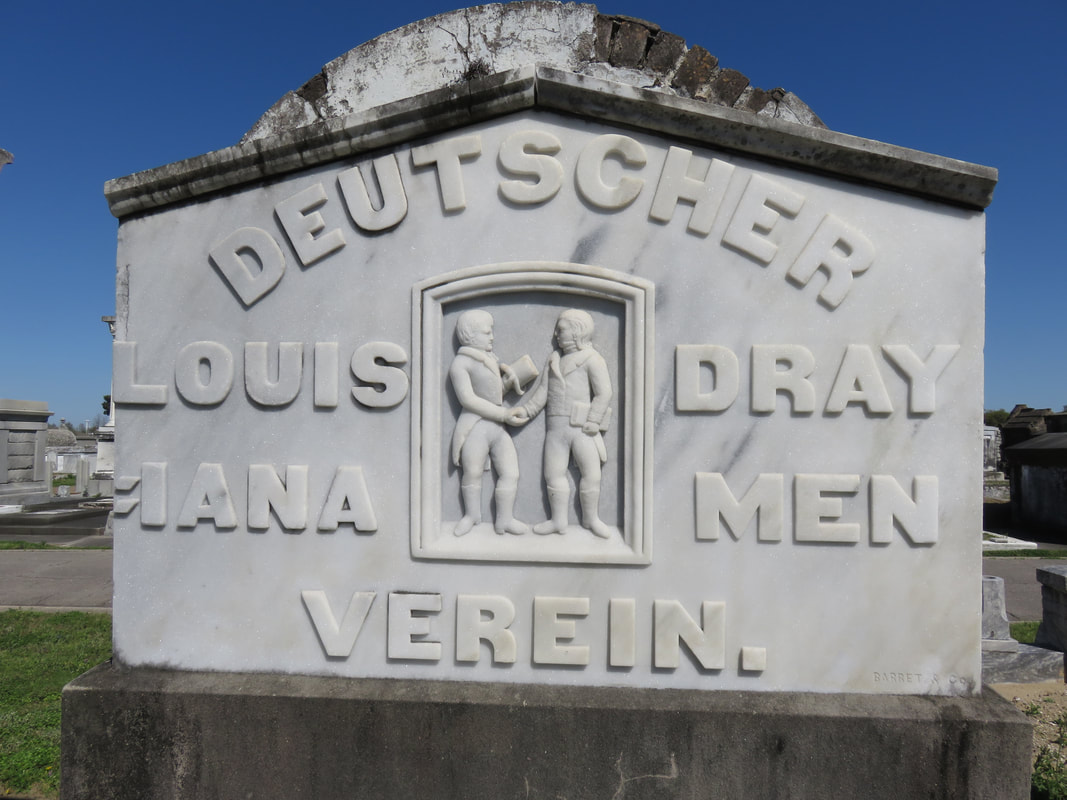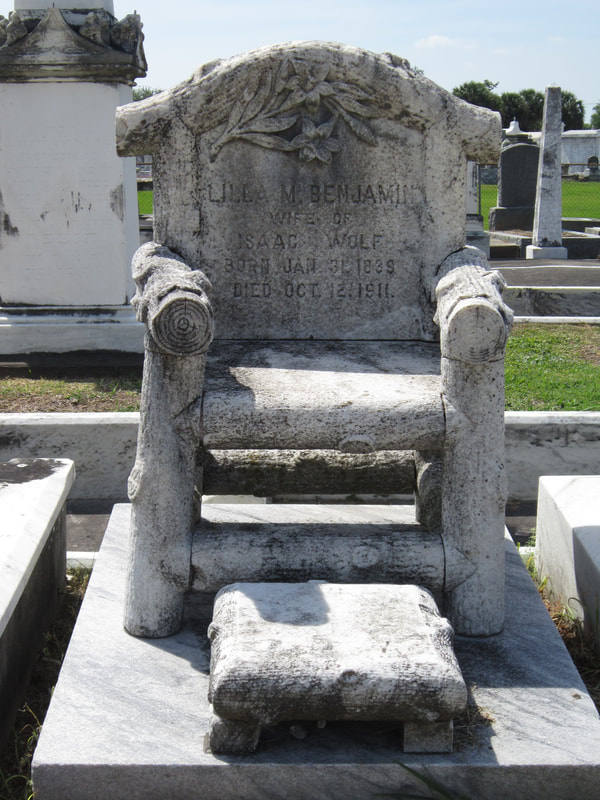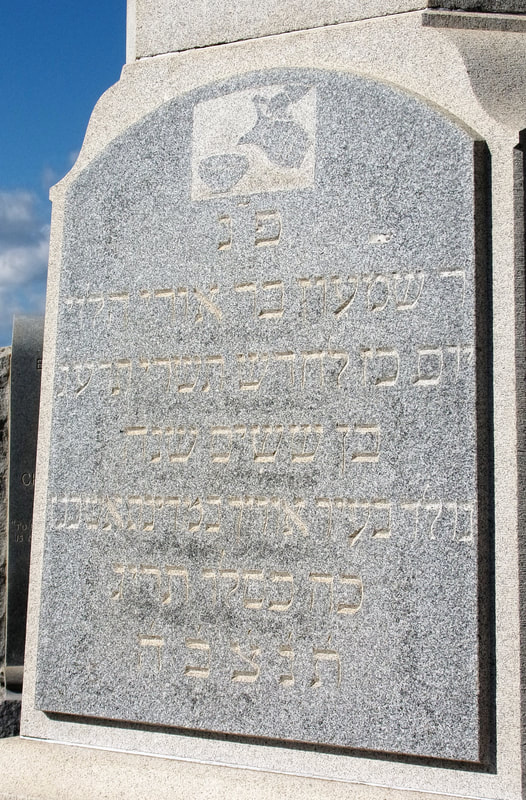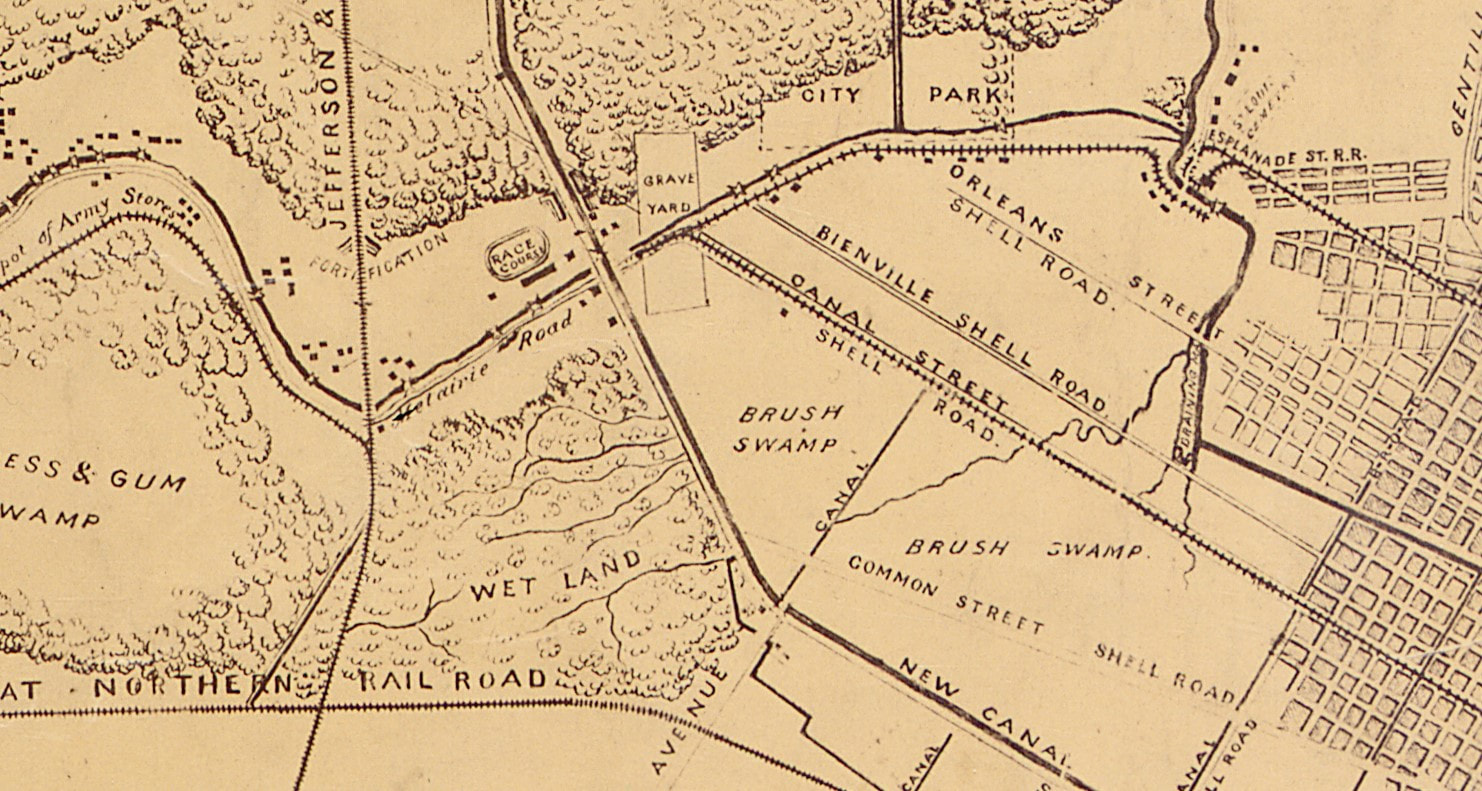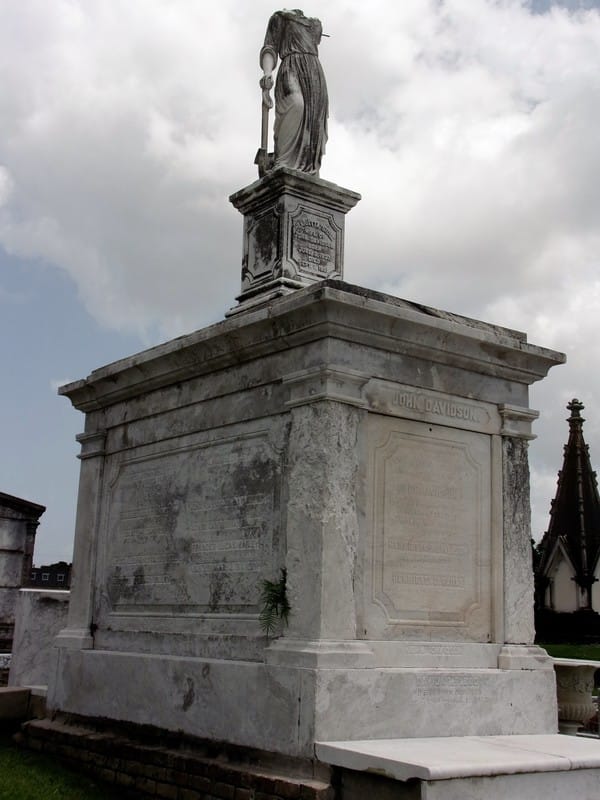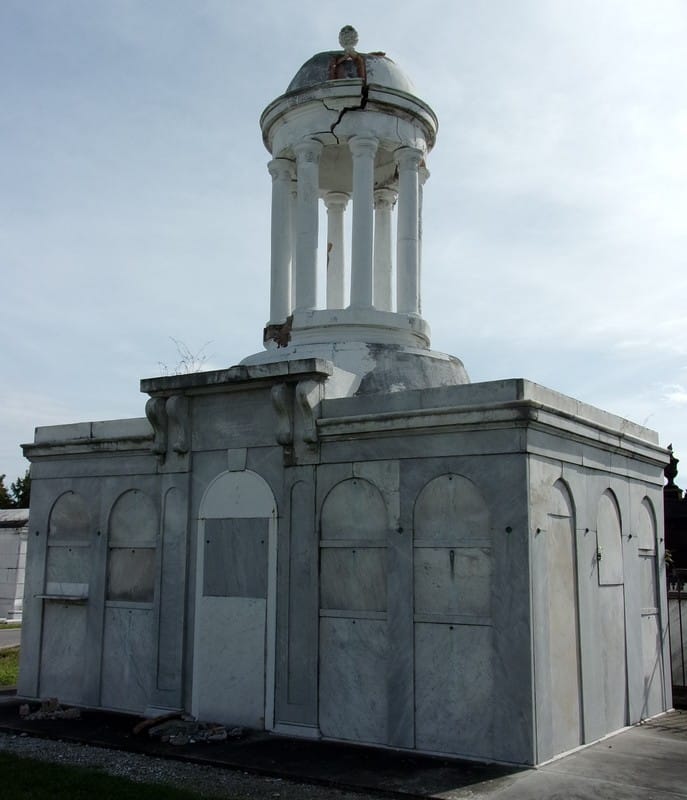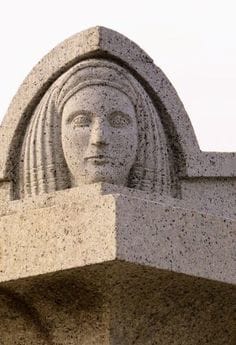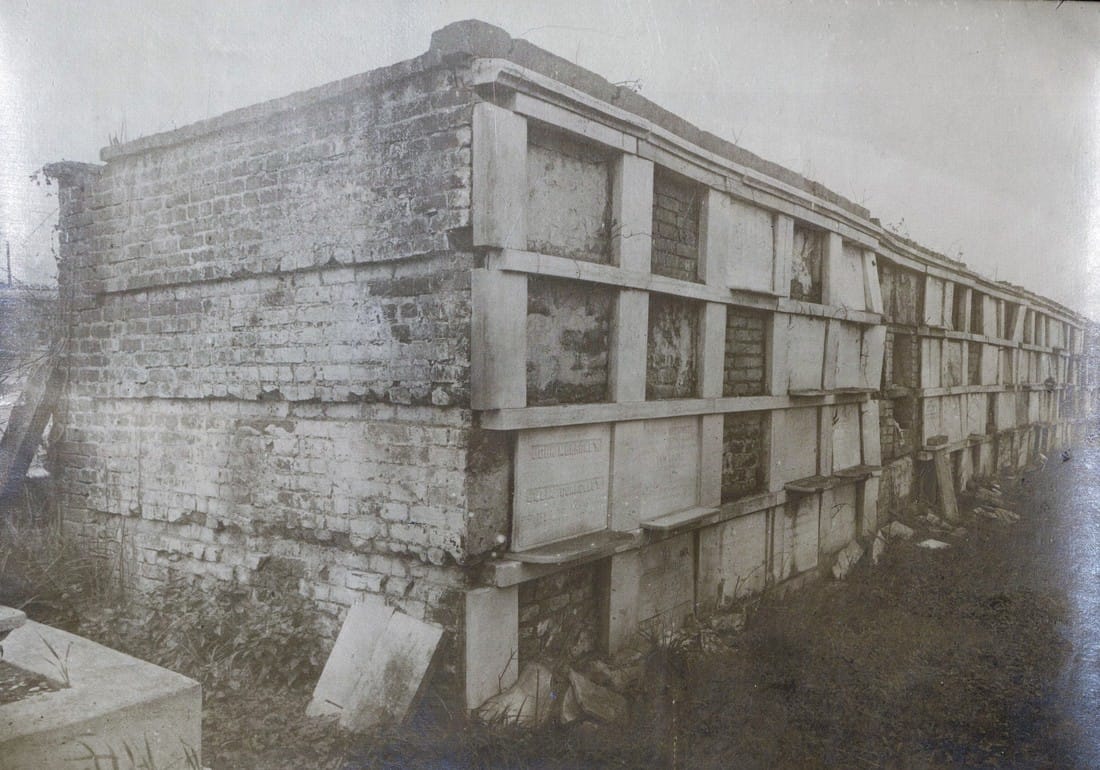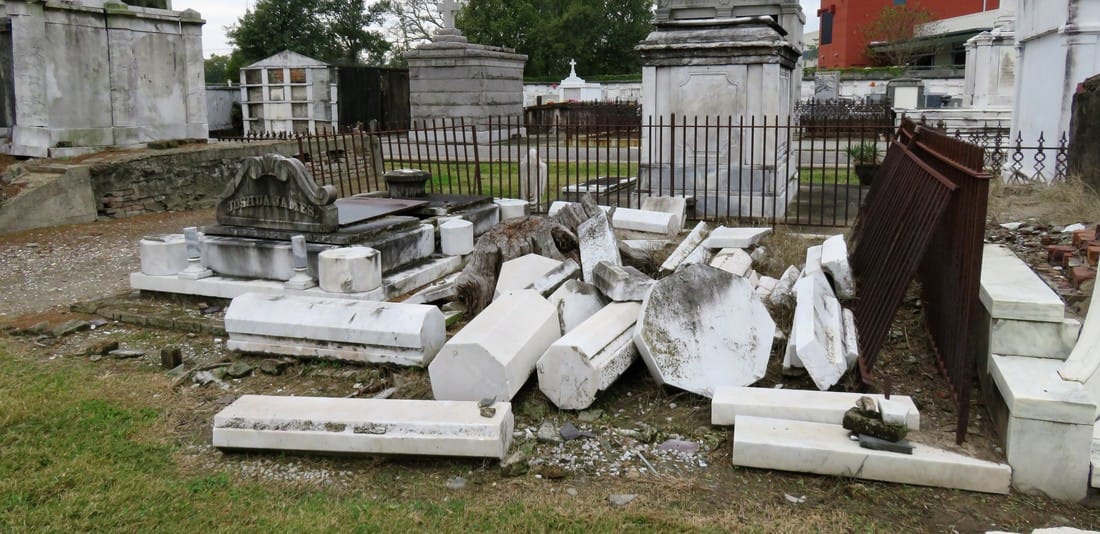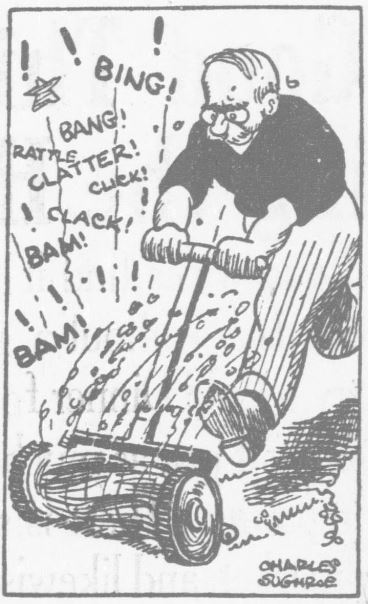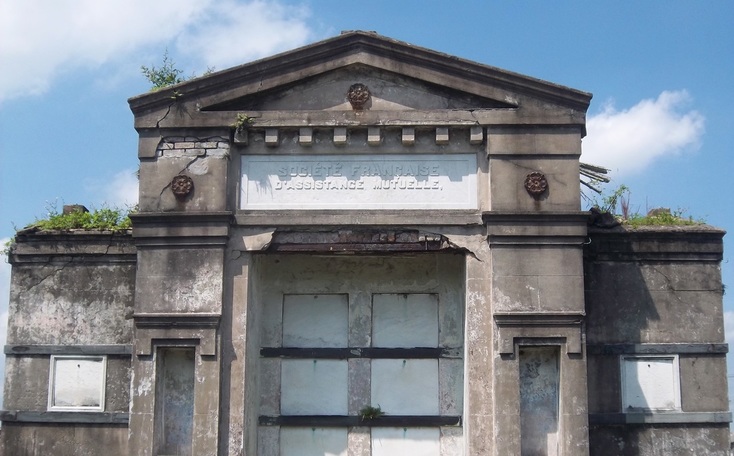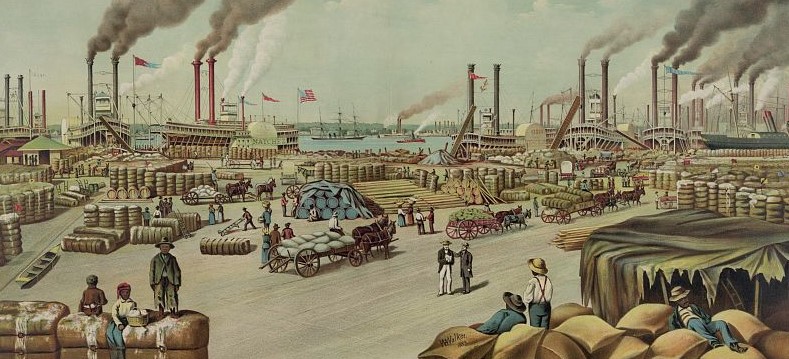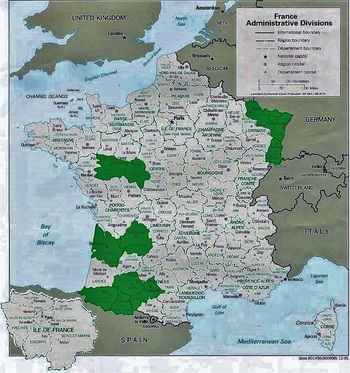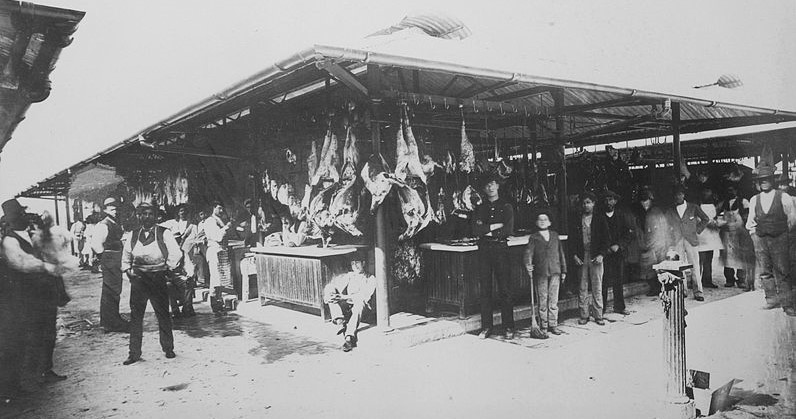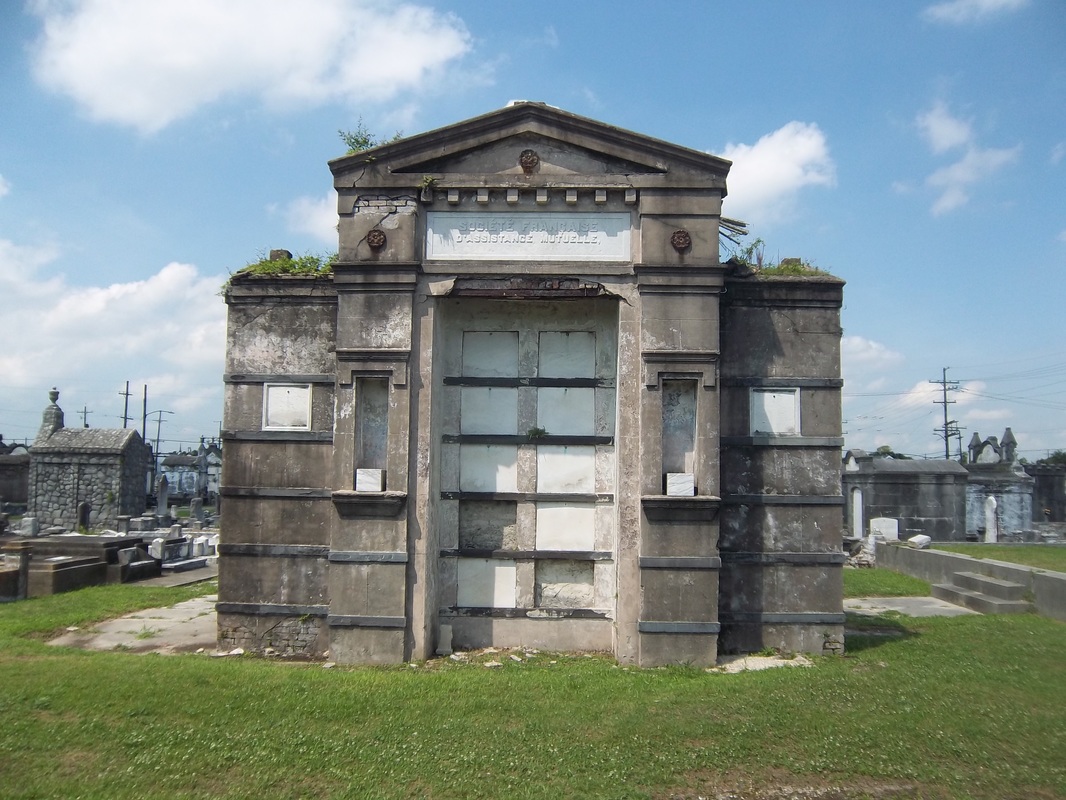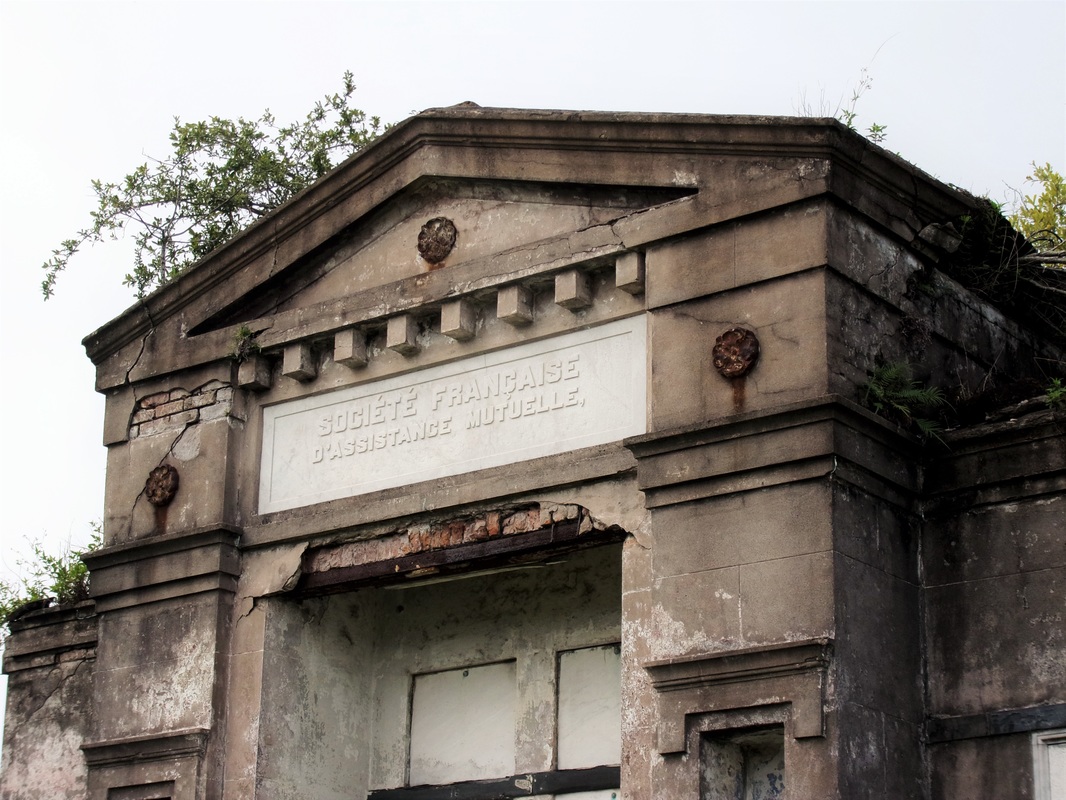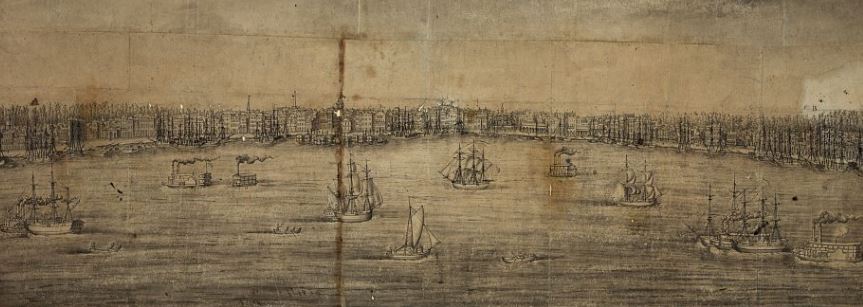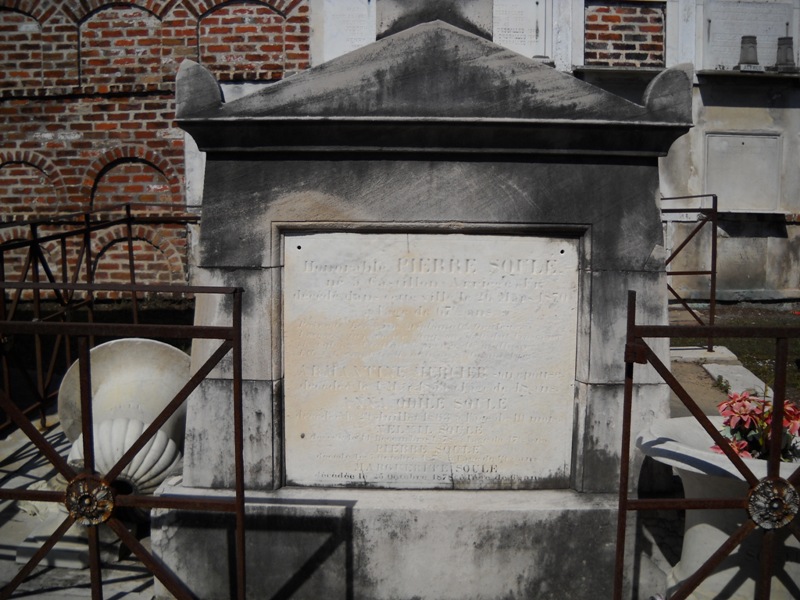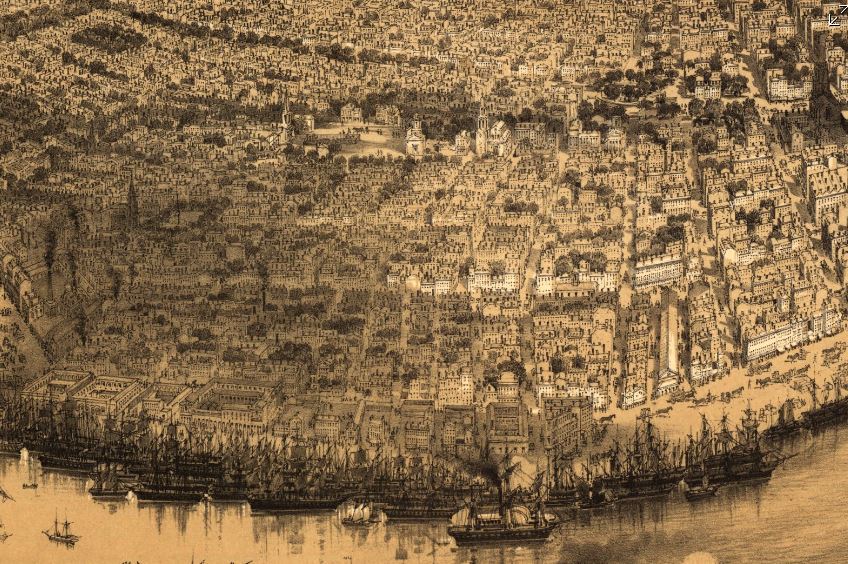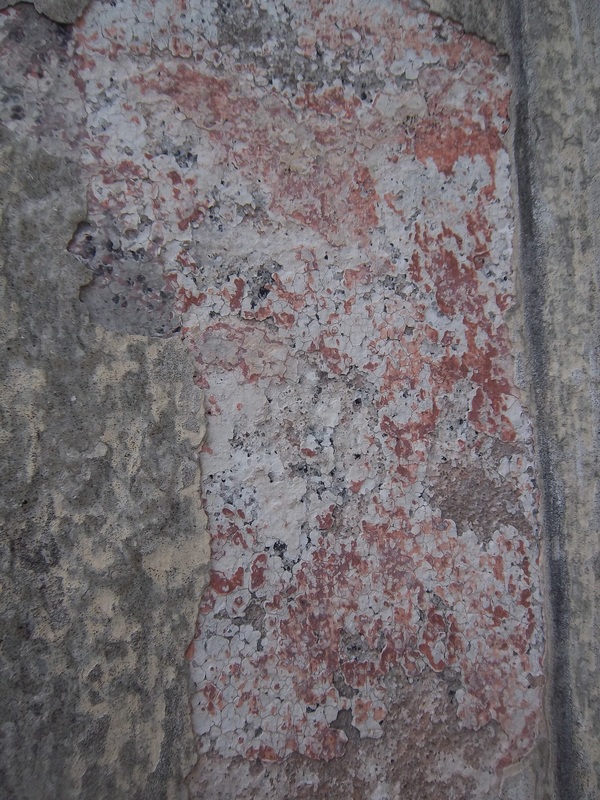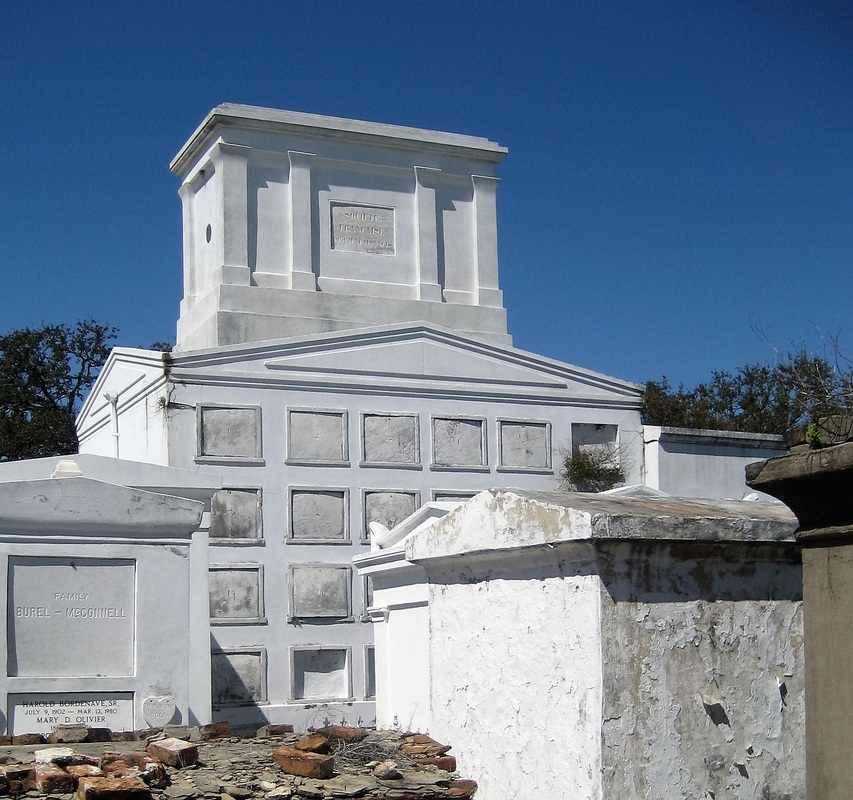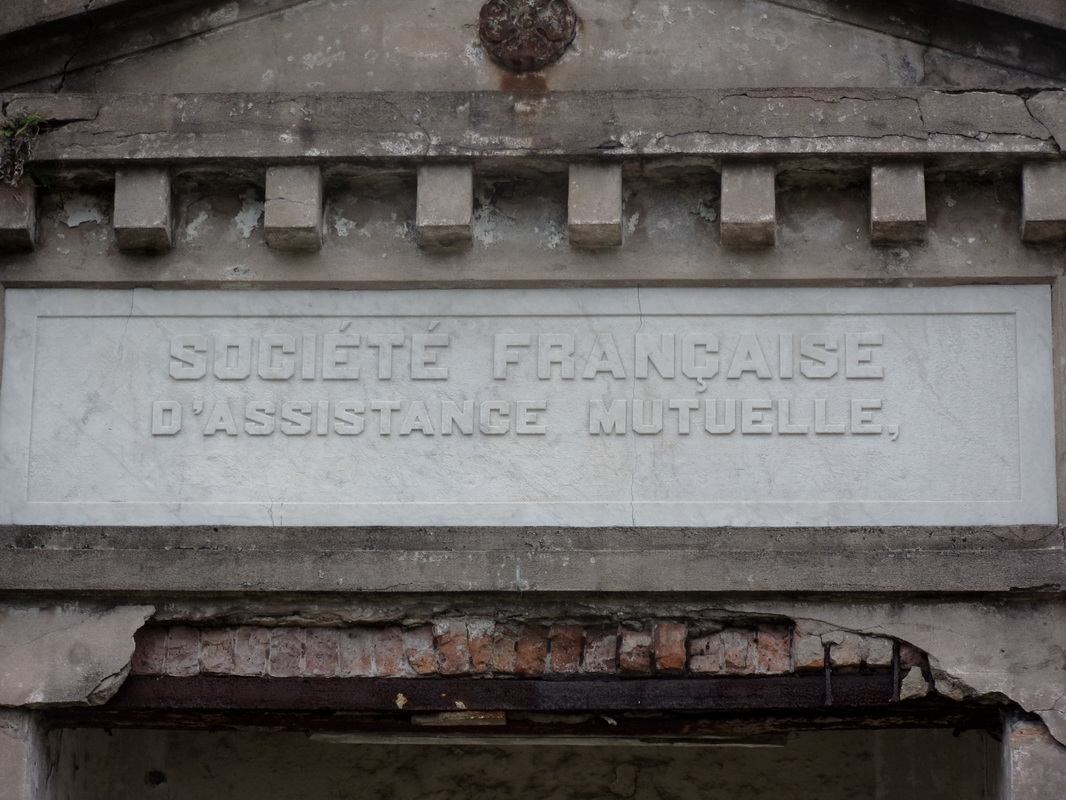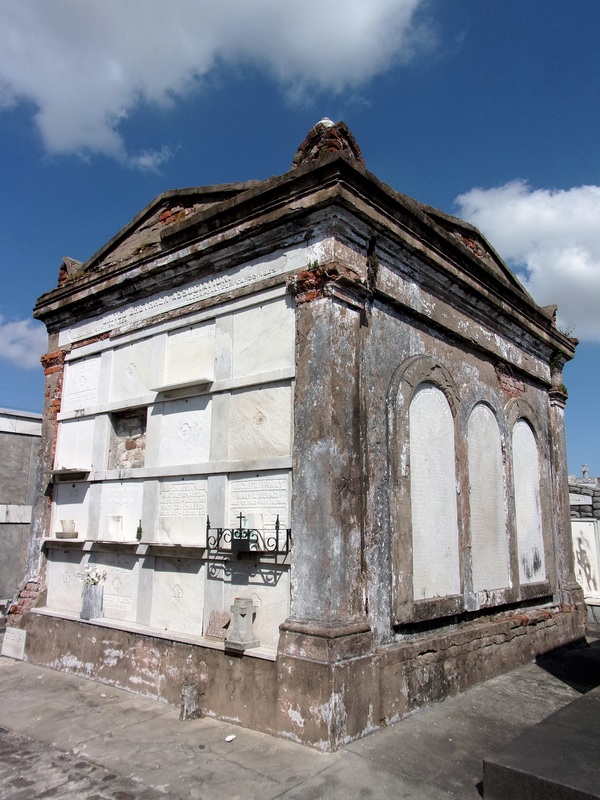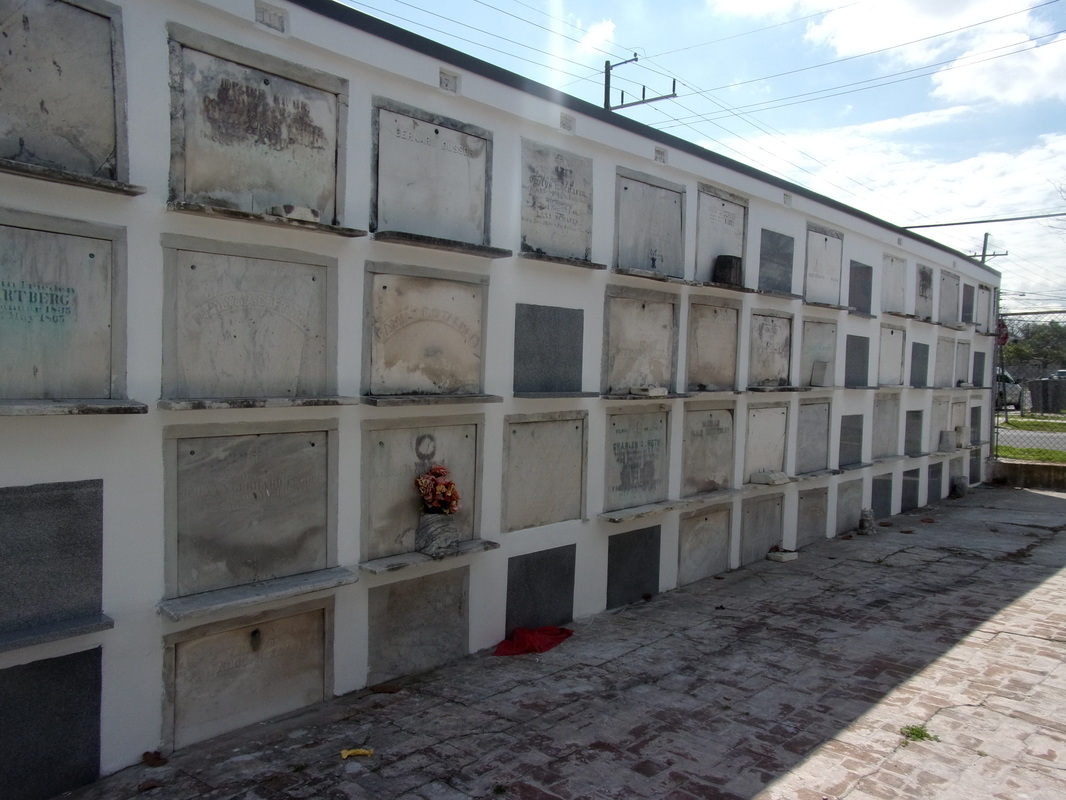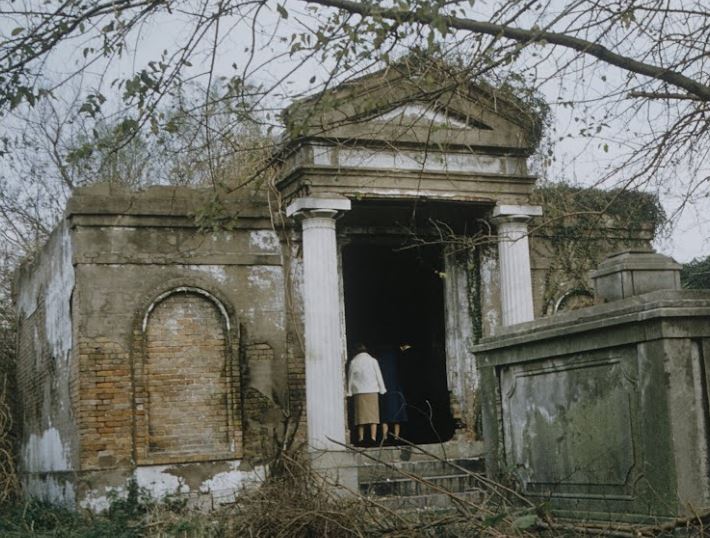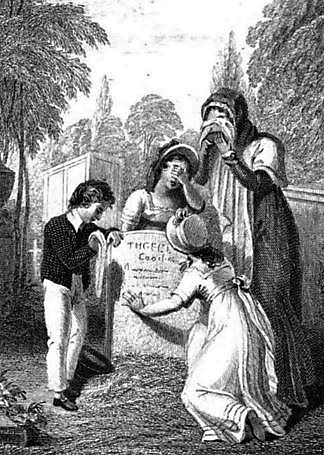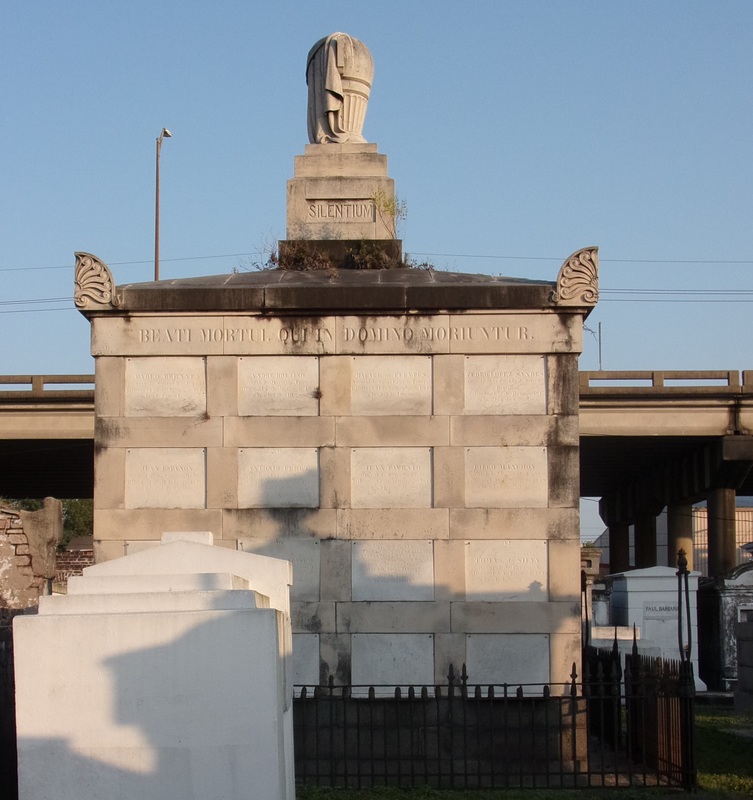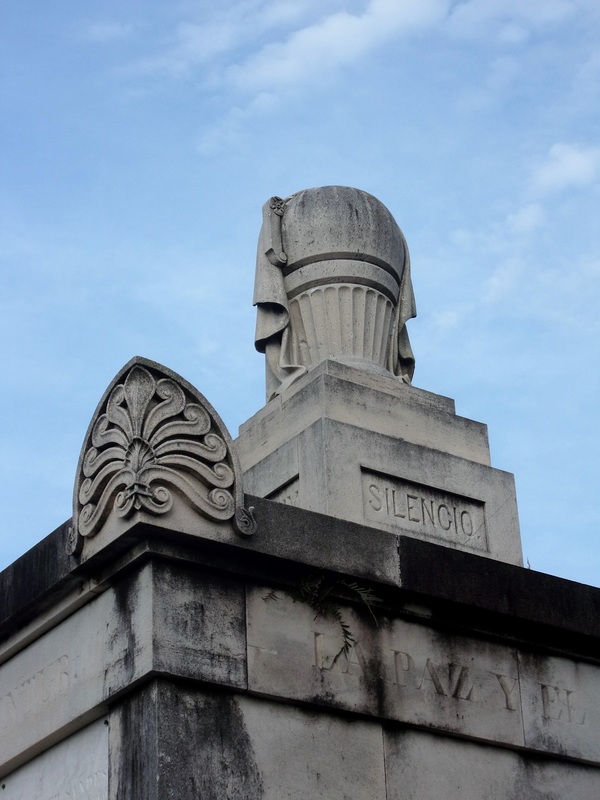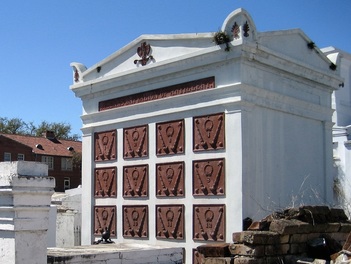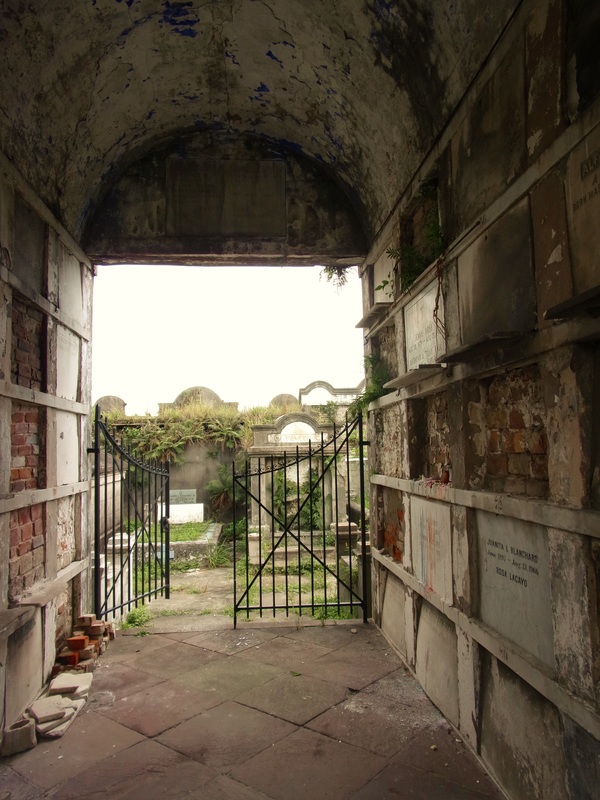|
This is the fifth and final part in a five-part series on the historic landscape of City Park Avenue and Canal Street, and its associated cemeteries. From July to November 2017, construction will take place at this intersection to connect the Canal Streetcar to Canal Boulevard. To start at the beginning of this series, find Part One here, Part Two here, Part Three here, and Part Four here. By the 1930s, the intersection of Canal Street and City Park Avenue had undergone a century of extraordinary change. Where once Bayou Metairie meandered westward past acacia trees and a pastoral ridge, now City Park Avenue coasted across the New Basin Canal to become Metairie Road, past the grand monuments of Metairie Cemetery, and into Old Metairie. Where once the Egyptian Revival columns of Cypress Grove stood tall over an undeveloped landscape, now cars rumbled past the monuments and walls of Greenwood Cemetery and Odd Fellows Rest. Jazz blared from the Halfway House beside the New Basin Canal through the 1920s, until the House was converted into an ice cream parlor in 1930.[1] Bayou Metairie had slowly been filled in to accommodate City Park Avenue. To the east, Delgado Central Trades School (now Delgado Community College) was opened in 1921. Beside Delgado, Holt Cemetery remained the municipal potter’s field for New Orleans, but in 1940 the cemetery gained a new neighbor – the Higgins Boat Plant. PTs, Higgins, and the Cemetery Andrew Higgins (1886-1952) is known today in New Orleans as the man who brought the shallow-bottom PT and “landing craft, vehicles, personnel” or “LCVP” boats to the Allied effort in World War II. LCVP boats were used extensively in the D-Day invasion of Normandy in 1945, leading then-President Dwight D. Eisenhower to say in 1964 that Higgins had “won the war for us.” Before World War II, Higgins had gotten his start designing shallow-bottom boats that performed well in the Louisiana bayous and other waterways beset by submerged obstacles. But by the late 1930s, Higgins produced new designs that not only could achieve amphibious landings in shallow waters, but were also equipped with ramps to allow swift disembarkation upon landing. These qualities made Higgins Boats imperative to the war effort. In 1940, Higgins Industries constructed a $1.5 million boat-building facility in the least expected of places: far from water, along City Park Avenue, and beside Holt Cemetery. Ever known for his enterprising spirit, Higgins’ City Park plant became the “world’s largest boat manufacturing plant housed under one roof.”[1] The plant took advantage of the Southern Railway line that cut northwesterly across City Park Avenue, beside Masonic Cemetery No. 2. Boats would be manufactured at the City Park plant, which employed thousands of people, and shipped to Lake Pontchartrain for testing. The booming wartime production of the plant left the operation bursting at the seams. Said historian Jerry Strahan of Higgins’ need to expand: “The back of the shipyard was adjacent to Holt Cemetery. Higgins decided to enlarge the plant ‘knowingly and willingly’ by preempting an unused portion of the cemetery grounds. The plant was increased until 40 percent of the new facility was constructed on property to which Higgins held no title, a problem that was unresolved as late as 1947.”[2] Photos of the plant and adjoining Holt Cemetery can be found here under photographs numbered 14 and 21. As early as November 1945, the loss of massive wartime governmental contracts hit the Higgins plant hard. The property was put up for sale.[3] The building at 501 City Park Avenue would have myriad uses over the next thirty-five years – it was a Piggly Wiggly grocery store in 1948, offices for Georgia Pacific Corporation in 1959, and part of the building was used as an art warehouse in 1964.[4] From the 1960s through the 1970s, a van and storage company conducted business in the old plant. In 1972, the building was demolished - its walls, beams, floors, and other items sold for salvage.[5] Finally, in 1982, Delgado Community College opened the Arthur J. O’Keefe Administration Building at 501 City Park Avenue.[6] The architecturally intriguing building remains in the same capacity to this day. In 1964, Holt Cemetery would cease to serve as New Orleans’ potter’s field. The city of New Orleans, under coroner Frank Minyard instead leased a lot from Resthaven Cemetery in New Orleans East for this purpose. This section of Resthaven continues to serve as New Orleans’ indigent burial ground. The American Way of Death After the close of World War II, industries which had boomed forward industrially and technologically looked inward for domestic uses of their innovations. Higgins Industries attempted to this very thing: selling Higgins-designed watercraft for private uses. While to contemporary readers it may seem strange, the same phenomenon took place in the funeral and cemetery industries. Moreover, the clientele of these industries had changed: they were more prosperous, more mobile, and had different values. For 1950s Americans, death was to be confronted with more discretion, privacy, and modernity than had been the case for previous generations. The cultural boom of the 1950s held an inherent disdain for the old-fashioned. This trend is often best exemplified in the scorn held for Victorian architecture during this period. Modern Americans sought urban renewal to wipe away old landscapes. In New Orleans, such sentiments manifested in the rapid construction of community mausoleums, establishment of “memorial park” style cemeteries like Garden of Memories, and the destruction of Girod Street Cemetery. Girod Street Cemetery was established in 1822 at the foot of Girod Street near Liberty Street. By the mid-1950s, the cemetery was bounded by the New Orleans Union Passenger Terminal, part of a neighborhood seen as old, blighted, and an obstruction to progress. After repeated attempts by the cemetery’s owner, Christ Church Cathedral, to resurrect the cemetery both architecturally and functionally, it was expropriated by eminent domain to the federal government and the City of New Orleans. The cemetery was demolished in 1957. Girod Street Cemetery was located far from the Canal Street cemeteries, but it held certain cultural and architectural ties to other Protestant-dominated cemeteries like Cypress Grove and St. John’s Lutheran Cemetery. As the process of demolition began, the Huber family which had assumed ownership of St. John’s Cemetery in the 1920s, jockeyed for the contract to relocate the Girod Street remains. This competition involved multiple cemetery craftsmen-turned-cemetery owners and would not be the last time a cemetery operator competed for business with his peers. At the same time Girod Street Cemetery was being demolished, cemeteries at Canal Street and City Park Avenue were modernizing. The first inklings of cemetery stoneworkers turning to cemetery operation began in the 1910s and 1920s. For example, in 1910, stonecutter Albert Stewart assumed ownership of St. Vincent de Paul Cemetery on Louisa Street, acquiring it from the Suarez brothers. The Huber family had gained ownership of St. John’s Lutheran Cemetery in the 1920s – and by the 1930s, began construction on Hope Mausoleum, the first community mausoleum in New Orleans. Community mausoleums had gained some traction in the United States beginning in the 1890s and increasingly so in by the time of the Great Depression. In this era, the idea of a large, single-structure facility for burial appealed to cultural ideals of mutual benevolence (indeed, many belonged to fraternal societies like the Masons and Odd Fellows) and frugality. In New Orleans, these cultural desires were often met instead with society tombs – large, multi-vault structures within larger cemeteries. Society tombs were New Orleans’ version of community mausoleums, which reflected a more northern aesthetic. It is, then, not surprising that the Huber family gained ownership of German Lutheran St. John’s Cemetery and erected Hope Mausoleum around the historic burial ground. The development almost appears as an extension of St. John’s, Girod, and Cypress Grove Cemetery’s tendency to reflect non-Francophile aesthetics. In the early 1930s, Hope Mausoleum opened, a modestly Art Deco edifice encased in polished marble and touting itself as, “The Modern Way of Burial.”[8] The postwar boom of the 1950s saw a second heyday for community mausoleums, but these mausoleums suited newer cultural norms. The era valued opulence and modernity, sleek, state-of-the-art materials and a dearth of filigree and detail. The funeral and cemetery industries, rising into a new period of lobbying professional organizations, consolidated costs, and property accumulation, responded in kind. Indeed, author Jessica Mitford in her 1963 indictment of the industry, The American Way of Death, compared the contemporary funeral industry to the car industry of the same age: overloaded with space-age fins and baubles.[9] Thus, the new community mausoleum was meant to be an expression of modernity and opulence, and a doing-away with the stodgy funereal rituals and trappings of the past. Into this new market rose the children of Albert Stewart – Frank Sr. and Charles Stewart. Under their business, Acme Marble and Granite Company, the Stewarts purchased land adjoining the north boundary of Metairie Cemetery and set forth to construct a community mausoleum for the age. Completed in 1958, Lake Lawn Mausoleum would be the “the ultimate in modern burial,” with “paneling of rich mahoganies, carpeted floors, custom-built furniture, and rare plants and flowers.”[1] Lake Lawn would be the anti-Girod Street Cemetery. Historic photos suggest that Lake Lawn advertised within the walls of Girod Street, declaring that burials removed from the old Protestant cemetery could be moved to a thoroughly modern location. In fact, the engineer of Girod Street Cemetery’s demolition, Mayor deLesseps Story “Chep” Morrison, did just that. The contents of the Story family mausoleum, relatives of Mayor Morrison, were moved to Lake Lawn Park Mausoleum in May of 1956. In the end, though, Hope Mausoleum would gain the contract to re-inter the white burials from Girod Street Cemetery. In accordance with contemporary segregation laws (even in death) Providence Memorial Park in Metairie would receive the African American burials from Girod Street. The torchbearer of urban renewal, Mayor Chep Morrison, would himself in death become part of the struggle between rising cemetery entrepreneurs, and the clash of new and old New Orleans cemetery culture. Shortly before his death in 1957, entrepreneurial monument man Albert Weiblen, who by this time had expanded his business to owning entire quarries in Georgia, purchased the entirety of Metairie Cemetery. His widow Norma maintained this enterprise after Albert’s passing, and when Mayor Chep Morrison perished in a tragic airplane accident in 1964, a standoff ensued between old Metairie Cemetery and modern, neighboring, Lake Lawn Park Mausoleum. Mayor Morrison had, as mentioned previously, moved his family’s remains from Girod Street Cemetery to Lake Lawn Park Mausoleum. Yet while the new mausoleum was modern, Metairie Cemetery had been the lauded resting place of New Orleans mayors, governors, and Mardi Gras kings (nine, eleven, and more than fifty, respectively[1]). Metairie’s position in New Orleans culture was to be the hallowed resting place of power in all its forms. Presumably to preserve this reputation, Norma Weiblen called Morrison executor William H. Lindsay, Sr. on May 24, 1964, offering the Morrison family very steep discounts on a new tomb in Metairie Cemetery if they would consider moving Mayor Morrison’s burial there from Lake Lawn Park. She added that Lake Lawn Park was a “stinkpot,” and that she “knew [Metairie Cemetery] was where [Morrison] belonged.”[2] Years later, the matter would result in a lawsuit. Morrison was buried in Metairie Cemetery and, in 1969, Stewart Enteprises purchased Metairie Cemetery, renaming the joined properties “Lake Lawn-Metairie Cemetery.” The modernization of historic cemeteries at the end of Canal Street was fueled by the spirit of an era – and a struggle for space. By the 1950s, many of the cemeteries in the area were more than a century old. Furthermore, the city of New Orleans and the suburb of Metairie had grown tightly around them, leaving no room to expand. Community mausoleums were a practical way to capitalize on sellable space. Metairie Cemetery had made such a venture – filling in one of the cemetery’s lagoons to construct Metairie Mausoleum in 1958. In 1964, the various parish-owned Catholic cemeteries in New Orleans would be consolidated under the new New Orleans Archdiocesan Cemeteries. Ten years later, the Calvary at the rear of St. Patrick Cemetery No. 1 would be demolished to construct Calvary Mausoleum. In 1969, the Firemen’s Charitable Benevolent Association would open Greenwood Mausoleum. The Jewish cemeteries at the end of Canal Street would also reorganize ownership. In the late 1950s, the Hebrew Burial Association would form to assume ownership of Dispersed of Judah Cemetery, the oldest surviving Jewish Cemetery in New Orleans. With religious restrictions against above-ground burial, the cemetery instead appears to have expanded toward Bernadotte Street in this time, where today a section of modern, 1950s granite monuments stands. In 1973, conservative congregation Chevra Thilim established Chevra Thilim Memorial Park in a small triangle of land bounded by St. Patrick Cemetery No. 2, Dispersed of Judah Cemetery, and Iberville Street. In 1999, Chevra Thilim merged with another congregation to form Shir Chadosh congregation, who retains ownership of the memorial park-style cemetery. Canals, Streetcars, and Automobiles Within cemetery walls, local stonecutters became sales agents and marble increasingly gave way to increased use of granite. No longer the city’s potter’s field, Holt Cemetery became a burial ground for the families of those already interred therein. Outside the cemeteries of Canal Street and City Park Avenue, water and soil gave way to concrete and pylons The New Basin Canal, in service since 1838 and arguably the heart of the cemeteries landscape, was by the 1950s no longer fit for industrial use. As with Bayou Metairie before, the canal was filled in and repurposed for automobile use. In 1958, a new overpass was constructed for City Park Avenue traffic to traverse over the canal, but its use would be short lived. By 1962, sections of the canal nearest to Lake Pontchartrain were filled in and became West End Boulevard. At the end of the wide boulevard’s neutral ground, a civil defense bunker was constructed as a station of command for government in the event of nuclear war. The bunker has been abandoned since the late 1990s, but remains present on West End Boulevard near Robert E. Lee Boulevard. Finally, in 1968, plans that had begun in the 1950s with Mayor Morrison came to fruition and a superhighway was constructed to connect Baton Rouge and New Orleans. The Pontchartrain Expressway, part of Interstate 10, was constructed above the filled-in New Basin Canal – replacing high levies and deep water with tall pylons and dipping underpasses. Increased automobile traffic was met with increased automobile infrastructure, but one seemed to continually outpace the other. The roadways as they were in 1968 were complex and disconnected: Canal Boulevard met City Park Avenue, which met Canal Street in a dog-leg which already vexed motorists. The triangular lot of Odd Fellows Rest formed this dog-leg, and in the 1960s, civic eyes turned to eliminate the obstacle. The (sort-of) Battle for Odd Fellows Rest As early as 1948, New Orleans’ City Planning Commission recognized the “dog-leg” problem.[13] As automobile drivers increasingly used Canal Boulevard and Canal Street as a commuter route to and from the city, the multiple turns needed to achieve this route caused traffic congestion. While the commission desired nothing more than to connect the two streets, Odd Fellows Rest cemetery had sat firmly between them since 1849. By 1963, the plan to “bypass” Odd Fellows Rest was revived. The Planning Commission announced in August of that year that it sought to purchase “the entire Odd Fellows Rest on the downtown river side of the intersection of Canal st. and City Park ave. and a very small portion of the adjoining St. Patrick No. 2 cemetery.”[14] The City would purchase the cemetery, relocate the remains interred therein, and demolish the remainder in order to connect Canal Street and Canal Boulevard. Like its neighboring cemeteries, Odd Fellows Rest had struggled to transition from the nineteenth century to the postwar era. In 1950, the Grand Lodge of Louisiana Independent Order of Odd Fellows (IOOF) hired stonecutter Armand Rodehorst, Sr. as the new superintendant of the cemetery.[15] Rodehorst had worked for fifteen years across the street at Greenwood Cemetery, as a laborer for Samuel Gately. In joining Odd Fellows Rest, he was striking out on his own.[16] Rodehorst developed Odd Fellows much in the same way that other cemeteries had done. He built multi-vault tombs to sell piecemeal and constructed modern, cast-concrete tombs. In 1958, however, Rodehorst died in his home at the age of 56.[17] The economic future of Odd Fellows Rest was left without a helmsman. Thus, by 1963, the Louisiana Grand Lodge was positioned to sell the cemetery property, although “not interested in partial relocation, but in total relocation of the cemetery.”[18] City Council, Mayor Victor Schiro, and the Planning Commission agreed to fund the project. Property on City Park Avenue near Delgado Community College was selected, which the City would purchase and gift to the Odd Fellows for transfer of the cemetery’s remains. City Council purchased a lot “bounded by City Park Avenue, Conti Street, Virginia Street, and St. Louis Street” for the purpose.[19] Yet in a twist of fate perhaps unique to New Orleans and its local politics, a private firm learned of the land purchase and beat the City to the punch. The purchaser, Plaza Towers, Inc., bought the property and, in turn, offered to gift it to the City in exchange for another parcel of municipal land located on Howard Avenue and South Rampart. Unlike the City Park Avenue property, which was purchased only as leverage, the Plaza Towers firm needed the Howard Avenue property in their construction project: the forty-five story Plaza Tower building designed by Leonard R. Spangenberg, Jr. & Associates. This obvious power grab left City Council “irate.”[20]
In August of 2005, flooding caused by Hurricane Katrina effected even the cemeteries of Metairie Ridge. Metairie Cemetery lost its administrative building near the cemetery entrance, and untold tombs were damaged. In 2008, state-owned Charity Hospital Cemetery was converted into a memorial to the lives lost in Hurricane Katrina. The property was excavated and analyzed by archaeologists, and large vaults were erected, clad in reflective black granite. The unidentified and unclaimed remains of 86 hurricane victims were interred at this site, which each year is visited and dedicated on the anniversary of Katrina’s landfall. To learn more about the inspiring, harrowing, and touching story of the Katrina Memorial, please read this fantastic piece by Mary LaCoste in the Louisiana Weekly: “Remembering the Katrina Memorial that Almost Wasn’t.” The Last Days of the Halfway House The Halfway House, once positioned tranquilly along the New Basin Canal but by 2005 instead wedged beside the Interstate 10 overpass, was also damaged in the storm. Beginning in the 1840s as a place of rest and refreshment for carriages en route to Lake Pontchartrain, later a restaurant and jazz hall, then an ice cream parlor, the building was purchased in the 1950s by Orkin Pest Control Company. Abandoned by Orkin in the mid-1990s, by 2005 the property was derelict, its roof partially collapsed. The Halfway House was the property of the Firemen’s Charitable and Benevolent Association, held by a long-term lease by the city of New Orleans. After Hurricane Katrina, plans were set in motion to convert the adjoining property – once Albert Weiblen’s marble shop – into the new 911 Communications Center for the city. It looked as if the Halfway House would be demolished to make way for a parking lot. Even before 2005, an organization called the Jazz Restoration Society worked with the FCBA and City to secure ownership of the Halfway House, with the goal of restoring it to a restaurant and music hall. Years of infighting, pushing and pulling, and negotiations in the city finally ended in 2009, when the building was declared a landmark and the Society was given permission to step in. But, much like the land deal between the City and Odd Fellows Rest, another shoe had to drop. When an environmental assessment was conducted at the Halfway House, soil tests found that forty years of pesticide storage and disposal left the property unsalvageable by even the best intentions. Despite years of fighting to save the Halfway House, it was demolished in 2010. Conclusion As of this writing, the current road construction project at the intersection of Canal Street and City Park Avenue is on-schedule and should be finished in one week. Streetcar lines are laid, sweeping across City Park Avenue and onto Canal Boulevard. Archaeological assessments and relocation of remains from the cemetery beneath Canal Boulevard have taken place. Soon, the intersection will assume its most recent form, in a place that has held so many forms for one hundred and eighty years. In this series, we have seen this place conform to cultural changes, urban expansion, technological innovation, war, and peace. It is a testament to how imperceptibly dynamic New Orleans cemeteries are – that we can walk through them and feel tranquility and stillness, when in reality they’re shifting, conforming, losing and gaining things that will be held precious by future generations. And there’s even so much we’ve left out! Left out was the Perseverance Lodge No. 13 society tomb in Cypress Grove, hit by lightning twice in the late twentieth century and recently reconstructed by FCBA. Left out was the flower shop on Canal Street beside Cypress Grove, once a hub for chrysanthemums and roses shuttled off to the cemeteries, by the 1990s derelict, and demolished in 2016. The merger of Stewart Enterprises, Inc. with Service Corporation International in 2014 merits its own thousand words on the industrialization of funeral and cemetery industries. Uncountable changes have taken place in this tiny colony of cities of the dead. This retrospect, more than anything, then, has been an overture to recognizing how very important those aspects of our cemeteries which have survived all of this. From Cypress Grove to Chevra Thilim Memorial Park, from Lake Lawn Park Mausoleum to Holt Cemetery, it is impossible to appreciate these relics too much. [1] Samuel Charters, A Trumpet Around the Corner: The Story of New Orleans Jazz (Oxford: University Press of Mississippi, 2008), 257.
[2] Jerry Strahan, Andrew Jackson Higgins and the Boats that Won World War II (Baton Rouge: LSU Press, 1994), 49-50. [3] Ibid. [4] “For Sale: Two of the Modern Higgins Industrial Plants and Clinic in New Orleans,” Times-Picayune, November 19, 1945, 17. [5] Times-Picayune, April 11, 19; Times-Picayune, October 6, 1959, 27; Times-Picayune, April 5, 1964, 71; Times-Picayune, February 10, 1964, 45. [6] “Higgins Shipyard,” Times-Picayune, August 12, 1972, 44. [7] “Congratulations Delgado,” Times-Picayune, March 4, 1982, 19. [8] “The Modern Way of Burial” was Hope Mausoleum’s official slogan from the 1930s through the 1950s. For example, “Hope Mausoleum,” Times-Picayune, May 2, 1935, 2; and “Hope Mausoleum,” Times-Picayune, January 26, 1958, 2. [9] Jessica Mitford, The American Way of Death (New York: Simon & Schuster, 1963), 20-21. [10] “Lake Lawn Park Mausoleum,” Times-Picayune, October 3, 1954, 15; “Lake Lawn Park and Mausoleum – A Report on Progress,” Times-Picayune, October 30, 1951, 10. [11] Henri A. Gandolfo, Metairie Cemetery: An Historical Memoir (New Orleans: Stewart Enterprises, Inc., 1981), 108. [12] “Details on Switch of Morrison’s Burial Site Revealed,” Times-Picayune, May 5, 1966. [13] “End to Canal ‘Dog-Leg’ Urged,” Times-Picayune, August 11, 1963, 1. I would like to recognize and thank Michael Duplantier for sharing resources and information contained in the (sort of) Battle for Odd Fellows Rest section. [14] Ibid. [15] “Odd Fellows Cemetery,” Times-Picayune, December 26, 1950, 41. [16] Soards’ New Orleans City Directory for 1935, Vol. LXI (New Orleans: Soards Directory Co., Ltd., Publishers, 1935), 1171; Polk’s New Orleans City Directory 1938 (New Orleans: R.L. Polk & Co., 1938), 933; Polk’s New Orleans City Directory 1949 (New Orleans: R.L. Polk & Co., 1949), 1209. [17] “Business, Civic Leader Expires: Rodehorst Rites will be Held Today,” Times-Picayune, September 16, 1958. [18] “Accord on Canal Street ‘Dog Leg’ Plans Possible,” Times-Picayune, November 7, 1963, Section 2, 6; “Lodge to Help on Street Link,” Times-Picayune, August 20, 1963, 7. [19] “Cemetery Head Petitions Court,” Times-Picayune, August 1, 1968, 9. [20] “Council Irate at Land Deal: City Officials Criticized for Failure to Buy,” Times-Picayune, June 3, 1964, 1. [21] “Cemetery Head Petitions Court,” Times-Picayune, August 1, 1968, 9. [22] Edward J. Branley, New Orleans: The Canal Streetcar Line (Arcadia Publishing, 2004), 95.
1 Comment
This is Part Three in a multi-part blog series examining the landscape history of what is now the intersection of Canal Street and City Park Avenue. From July to November 2017, construction will take place at this intersection to connect the Canal Streetcar to Canal Boulevard. Find Part One here and Part Two here. 1852: Greenwood Cemetery By 1850 the terminus of Canal Street remained mostly undeveloped. On each side of Canal approaching Bayou Metairie were the predominantly belowground Dispersed of Judah, St. Patrick’s, and Charity Hospital Cemeteries, each likely bounded by wooden fences. Improvements like the Halfway House, the Toll House, and the walls of Odd Fellows Rest modestly framed the monumental entryway to Cypress Grove Cemetery. Cypress Grove itself was more than a decade old and flourishing as a garden cemetery full of trees and landscape features – despite a fire in 1848 that destroyed many plantings.[1] The Firemen’s Charitable Association had been quite successful in developing Cypress Grove, so much so that demand for lots overran supply. In 1852, the FCA opened Greenwood Cemetery across Bayou Metairie from both Odd Fellows and Cypress Grove. Its eastern boundary would adjoin Cypress Grove Cemetery No. 2, also known as Charity Hospital No. 2. In some ways, Greenwood Cemetery would be a continuation of Cypress Grove – dedicated to the memorial of fallen firemen and stylistically influenced by Anglo-Protestant aesthetics over those of Creole New Orleaneans. In fact, it’s likely no accident that Greenwood Cemetery shared its name with a famous garden cemetery in New York, founded in 1838. However, Greenwood would not accommodate the landscape features and lofty architecture so well fostered by Cypress Grove. Instead, the new Firemen’s cemetery would be organized in compact, neat rows that mirrored the kind of order seen in contemporary cemeteries like St. Louis Cemetery No. 3 on Esplanade Avenue (est. 1854). A grand dedication ceremony like those seen at Cypress Grove and Odd Fellows Rest would not be held for Greenwood Cemetery. This may have been the result of an almost immediate cholera and yellow fever epidemic following the cemetery’s opening. The 1853 yellow fever epidemic would kill as many as 12,000 people in New Orleans, quickly making Greenwood a vital burial ground. Unlike Cypress Grove or Odd Fellows Rest, Greenwood Cemetery was not enclosed with a masonry wall, but an iron fence. This left the southern boundary of the cemetery visually open to the bayou that meandered in front of it. The grassy space left room for display of more impressive monuments. Decades would pass, however, before the most iconic monuments of Greenwood would appear. The Confederate monument (1873), Firemen’s monument (1887), and Elk’s Lodge tumulus (1911) did not yet rise above the bayou. Instead, one of the first monuments to be erected in Greenwood Cemetery would be that of two martyred firefighters. On March 16, 1854, Daniel Woodruff and William McLeod responded to a fire on Magazine Street as members of Mississippi Fire Company No. 2. In the blaze, a wall fell upon Daniel Woodruff and he was killed in action. Later, William McLeod died of injuries sustained in the fire.[2] Exactly one year after the tragic fire, the FCA laid the cornerstone of the fallen men’s memorial tomb. The Firemen traveled to Greenwood Cemetery in a procession to Metairie Ridge where the cornerstone was laid. In Masonic tradition, the architect of the tomb, Sheppard Reynolds, presented the Grand Master of the FCA with a plumb, square, and level with which to test the cornerstone. After it was pronounced level and plumb, the stone was anointed using vessels of corn, wine, and oil. After an oratory, the procession retreated.[3] The Woodruff-McLeod tomb, similar in style but not size to the Teutonia Lodge tomb, was completed by stonecutter and tomb builder Newton Richards (1805 – 1874), who also constructed the Irad Ferry monument. Each arched loggia-like vault memorializes the life and service of Woodruff and McLeod. Yet only one of the two martyrs are actually buried in this tomb. When the time came to re-inter William McLeod in Greenwood his widow objected. His body remained at Girod Street Cemetery. It is unclear where McLeod may have been re-interred after the demolition of Girod Street Cemetery in 1957.[4] Newton Richards had by 1859 constructed the Irad Ferry monument, the Woodruff-McLeod monument, dozens of other tombs in New Orleans cemeteries, and even the granite pedestal atop which the Andrew Jackson statue is mounted in Jackson Square.[5] A man from New Hampshire who specialized in granite monuments, Richards was especially active in the Anglo-Northern associated cemeteries. In 1859, he would once again shape the budding landscape of Greenwood Cemetery by erecting the memorial of former New Orleans mayor Abidel Daily Crossman in Greenwood Cemetery. A.D. Crossman served four consecutive terms as mayor of New Orleans, weathering the city through natural disasters like Sauve’s Crevasse and the 1853 yellow fever epidemic. He oversaw the re-joining of the city from three separate municipalities into one united city government, and local military response to the Mexican-American War. Crossman was from Massachusetts and had long been a friend of the city’s firefighters – serving as a firefighter himself under Eagle Company No. 7.[6] For Crossman, Richards erected a classical Doric column carved of granite and surmounted with an urn. The granite die and stacked bases atop which the column sits are enclosed with cast iron fencing, the corners of which are each topped with cast iron flaming lamps. The cemeteries at the end of Canal Street were tied not only by geography but, in some cases, mutual origins and culture, specifically that of Northern-born Americans. For this reason, it is no surprise that stonecutters and tomb builders with similar backgrounds tended to concentrate their work in Cypress Grove, Greenwood, and Odd Fellows. In fact, the first sexton of Greenwood Cemetery, Daniel Merritt, also served as sexton in Odd Fellows Rest. Carved tablets signed by Merritt are found in all three cemeteries.[7] Greenwood Cemetery greeted a peculiar new tomb construction in the 1860s – tombs built of brick and mortar but clad in cast-iron panels. This style was not exclusive to Greenwood (Lafayette Cemetery No. 1 had the Karstendiek tomb by 1866, and Cypress Grove famously houses the Leeds cast-iron tomb), but Greenwood gathered the highest concentration of these unique structures. Four of these tombs (Marks, Enberger, Summers, and Hetion) were identical catalog-order tombs from the ironwork firm of Wood, Miltenberger, and Company, which had a branch in New Orleans. The Edwards tomb, also of cast iron, was a custom construction erected in 1861 across the aisle from the Woodruff and McLeod tomb. 1858: Tememe Derech Cemetery Jewish immigration to New Orleans continued through the first half of the nineteenth century. Some Jews emigrated from France, Germany, and the contested territory of Alsace-Lorraine between the two countries. By the 1850s, however, other Jewish people from Eastern Europe began to arrive, fleeing pogroms in their home countries. In 1858, Polish Jews formed the Orthodox congregation of Tememe Derech (“The Right Way”). This congregation was the first Eastern European Jewish congregation to construct a purpose-built synagogue, once on Carondelet Street. Tememe Derech also established its own cemetery across Canal Street from Dispersed of Judah Cemetery, on what is now Botinelli Place.[8] Tememe Derech was not the only Eastern European Jewish congregation in nineteenth century New Orleans. Over time, other congregations formed and merged, and Tememe Derech itself merged with others in 1904 to form Beth Israel Congregation. The new congregation constructed a synagogue on Carondelet Street and designed by Emile Weil. This building is now the New Home Family Worship Center at 1616 Carondelet.[9] As congregations formed and merged among Eastern European Jews in New Orleans, Tememe Derech’s original cemetery would become the burying ground for other congregations, namely Chevra Thilim and later Beth Israel. In 1916, Beth Israel would construct a Metaher house (a traditional chapel for the cleansing of bodies) at the entrance to the Canal Street cemetery. This structure was demolished in the 1960s.[10] The 1860s: A Decade of Change With the addition of Greenwood and Tememe Derech Cemeteries in the 1850s, the confluence of Canal Street, New Basin Canal, and Bayou Metairie had six cemeteries within its bounds. In 1854, New Orleans City Park was founded. Larger than New York’s Central Park and home to the largest concentration of old-growth live oak trees in the world, City Park would add to the character of this area as a place of diversion and rural retreat. A portion of Bayou Metairie running through City Park would eventually be closed off to become a park lagoon. Today, this lagoon is the last remaining vestige of Bayou Metairie. New Orleans as a city was growing in both population and urbanized area. In 1861, the New Orleans City Railroad Company constructed a rail line extending up Canal Street from its foot at the Mississippi River all the way to Bayou Metairie, expanding access and development. The next year, the second fraternal cemetery in the area would arrive when Masonic Cemetery No. 1 and 2 opened at Bienville Street and Bayou Metairie. Despite steady development in the area, it would not escape the humbling effects of natural forces. Metairie Ridge had escaped the flooding of Sauve’s Crevasse in 1849, but would not be so lucky in 1860, when both New Basin and Carondelet Canals overflowed their levies and flooded the area.[11] Another crevasse in 1871 would inundate the cemeteries even more, when the New Basin Canal levy breached at the Halfway House, causing water to flow into the cemeteries.[12] By 1862, additional railroad track was present running alongside Bayou Metairie to the Halfway House. Through the Civil War and into the 1870s, New Orleans’ street grid would encroach toward the cemeteries. Nearby City Park, home to the famous “dueling oaks,” would not be the only venue for such bouts. In 1868, a duel between a Mr. “M” and a Mr. “G” was fought near the Halfway House with swords as the chosen weapon. Although neither man died in the match, neighbors in the vicinity soon afterward requested a police station be placed at the Halfway House – a request that the city council granted.[13] 1867: St. John Cemetery Another cemetery would join the landscape of Canal Street in 1867. Founded by German St. John Evangelical Lutheran Church, St. John Cemetery was the second Protestant cemetery in New Orleans (the first was Episcopal Girod Street Cemetery, founded 1822). St. John Cemetery was owned and managed by the church through the nineteenth century and was religiously restricted. Wrote Leonard Victor Huber, who later co-owned the cemetery with his family, under the church’s ownership “secret societies were not allowed to hold ceremonies in it, and Catholic priests were forbidden by their bishops to officiate services in it.”[14] St. John Cemetery was managed by a sexton who lived on the grounds. The small cemetery at Canal and Bernadotte Streets would develop over time into a typical New Orleans cemetery until the 1920s, when circumstances would transform it into a completely different type of cemetery.[15] The Civil War New Orleans was captured by Union forces in late April 1862, early in the Civil War. The American Civil War was also a time in which the culture and practice of death changed nationwide. Soldiers, accustomed to the concept of a “good death” instead died on battlefields, often buried where they fell. In New Orleans, bodies of both Union and Confederate soldiers were received, transported from elsewhere and buried in places like Cypress Grove Cemetery No. 2 and Chalmette Cemetery in St. Bernard Parish. After the Civil War, questions of claiming and memorializing the dead dominated conversation. Cypress Grove Cemetery No. 2, also referred to as Charity Hospital Cemetery No. 2, received the remains of both Federal and Confederate soldiers. In the 1870s, when the remains of Confederate soldiers were relocated from Chalmette Cemetery to Greenwood Cemetery, remains from other cemeteries including Cypress Grove No. 2 were reinterred in the same place. This effort was headed by the Ladies Benevolent Association of New Orleans, who erected the Greenwood Confederate monument atop this mass grave of 600 soldiers in 1873. The “Old Soldier’s Home,” established in 1866 by the State of Louisiana for Confederate veterans, also had a society tomb in Greenwood Cemetery by 1868. Remains of Union soldiers were also removed from Cypress Grove No. 2, as well. In the 1920s, as the old potter’s field was beginning to be redeveloped as a road and dumping ground, Federal soldiers were disinterred from Cypress Grove No. 2 and relocated to Chalmette National Cemetery. On All Saints’ Day, November 1, 1868, New Orleaneans observed the yearly tradition of decorating and visiting graves. The New Orleans Republican offered a glimpse of the Canal Street cemeteries on this day, noting the “noble monuments” of Cypress Grove, and nodding to the society tombs of the Deutscher Louisiana Draymen Verein (now mostly demolished), and the New Orleans Typographical Union in Greenwood Cemetery. Odd Fellows was described as well, “with its specious avenues bordered with trees and lined with the tombs of good and charitable men, is one of the most attractive of the homes of the dead.”[16] The rural cemeteries at Canal and City Park Avenue had matured into landscapes of marble, granite, limewash, and green landscaping. Each cemetery enclosed by masonry walls, picket fences, or painted ironwork, they framed canal and bayou as carriages and barges passed through. As much as the landscape had changed over three decades since the New Basin Canal opened, it was about to transform even further with the founding of an entirely new cemetery, the likes of which the city of New Orleans had yet to see. [1] Thomas O’Conner, editor, History of the Fire Department of New Orleans (New Orleans: Thomas O’Conner, 1891), 75.
[2] O’Conner, 84-85. [3] “Woodruff and McLeod Monument,” Daily Picayune, March 18, 1855. [4] Huber et. Al., New Orleans Architecture, Vol. III: The Cemeteries, 39. [5] “Inauguration of the Equestrian Statue of Andrew Jackson,” Daily Picayune, February 9, 1856, 2. [6] O’Connor, 127. [7] “Firemen’s Charitable Association, Cypress Grove and Greenwood Cemeteries,” Daily Picayune, June 17, 1855; “Odd Fellows Rest,” Daily Crescent, January 21, 1862. [8] Catherine C. Kahn and Irwin Lachoff, Images of America: The Jewish Community of New Orleans (Charleston, SC: Arcadia Publishing, 2005), 24; The Goldring/Woldenberg Institute of Southern Jewish Life, “History of Orthodox Congregations in New Orleans.” http://www.msje.org/history/archive/la/HistoryofOrthodoxCongregations.htm [Accessed September 10, 2017] [9] Barry Stiefel and Emily Ford, The Jews of New Orleans and the Mississippi Delta: A History of Life and Community Along the Bayou (Charleston, SC: History Press, 2012), 47, 77-80. [10] Huber et. Al., New Orleans Architecture, Vol. III: The Cemeteries, 22-23. [11] “Overflow of Canals,” Daily Crescent, October 4, 1860, 1. [12] “The Last Great Flood: Rear of the City Submerged,” New Orleans Republican, June 4, 1871, 1. [13] “Dueling,” New Orleans Republican, May 30, 1868, 3; “To the Common Council of the City of New Orleans,” New Orleans Republican, May 31, 1868. [14] Huber, et. Al., New Orleans Architecture, Vol III: The Cemeteries, 47-48. [15] Ibid. [16] “All Saints Day,” New Orleans Republican, November 2, 1868, 1. This is Part Two in a multi-part blog series examining the landscape history of what is now the intersection of Canal Street and City Park Avenue. From July to November 2017, construction will take place at this intersection to connect the Canal Streetcar to Canal Boulevard. Find Part One here. 1841: St. Patrick’s Cemetery At the same time that Americans from the northeast were moving en masse to New Orleans, a separate wave of immigration from Ireland made a great impact on the city. Immigrants fleeing famine and political unrest in Ireland came to New Orleans and settled mostly in what is now the Faubourg St. Mary neighborhood of New Orleans, abutting the Central Business District and what is now the Crescent City Connection bridge. These immigrants formed what is now Irish Channel, although the boundaries of this neighborhood have changed over time.[1] The neighborhood formed from settlement patterns dependent on the construction of the New Basin Canal. In 1833, the Parish of St. Patrick was founded to accommodate Irish Catholics in the neighborhood. By 1840, St. Patrick’s Church was constructed on Camp Street.
The St. Patrick Cemeteries, so fresh and clean in their snow-white garb and pebbly walks, always attract attention. Here lie the sturdy Irish pioneers who came to New Orleans in the early part of the last century and helped to make her history the proud tale it is… they breathe throughout the spirit of the Catholic faith. Special attention is directed to the beautiful Calvary shrine at the further end of St. Patrick’s No. 1 and the Mater Dolorosa that marks the entrance to St. Patrick’s No. 2.[3] The Calvary statue was designed by then-prominent monument man Charles A. Orleans, consisting of “a wooden cross twenty feet high with life-sized statues of the crucified Christ, Mary Mother of Jesus, His beloved disciple John, and Mary Magdelene. The statues were cast in Paris.”[4] In 1973, in the midst of trends toward community mausoleums, the Calvary was removed to make way for the Calvary Mausoleum. 1846: Dispersed of Judah Cemetery Along with Americans and Irish immigrants to New Orleans, another group of established immigrants and newcomers found their burial place at the end of Canal Street. Jewish people had long lived in New Orleans in small communities, first of primarily Sephardic Jews (of the Spanish-Portuguese tradition) from the Caribbean and England, then later Ashkenazi Jews from Germany and Alsace-Lorraine. These communities first organized in 1828 to found Gates of Mercy congregation, which had a synagogue on Rampart Street near St. Louis Cemetery No. 1. Gates of Mercy was an Ashkenazi congregation, and Sephardic Jews in New Orleans sought their own place of worship. This hope was fulfilled in 1846 when organizer Gershom Kursheedt helped aging benefactor Judah Touro found congregation Nefuzoth Yehudah (Dispersed of Judah) in 1846. Dispersed of Judah, a Sephardic congregation, was one of many religious organizations to benefit from Judah Touro’s generous will, which also founded Touro Infirmary, later to become Touro Hospital. In 1881, Dispersed of Judah and Gates of Mercy congregations would merge. The new congregation was eventually renamed Touro Synagogue. In the same year Dispersed of Judah congregation was founded, property adjoining St. Patrick Cemetery No. 2 along Canal Street was purchased for a cemetery. Dispersed of Judah was the second Jewish cemetery in New Orleans. Gates of Mercy had established a cemetery on Jackson Avenue near Saratoga Street in 1828, but this cemetery was demolished in 1957, part of a trend that will be discussed in a later part of this series. Thus, Dispersed of Judah Cemetery is the oldest surviving Jewish Cemetery in New Orleans. Members of Dispersed of Judah congregation were often tied to English colonial or business interests, arriving in New Orleans from the English-colonized Caribbean or New York. This Anglo-cultural tie, as well as a religious need to bury belowground, allowed Dispersed of Judah to grow into a small version of a northern cemetery. The landscape today retains some elements of this – box tombs and obelisks, trees, and raised monuments. The cemetery is probably best known for the marble monument of Lilla Benjamin Wolf (died 1911), carved into the shape of an empty chair with foot stool. A local story tells the sale of Mrs. Wolf sitting in her chair in life, outside her family’s shop, calling potential customers inside. This may have been a deeply personal choice of monument for the Wolf family, although “the empty chair” was also a common funerary symbol at the turn of the century. 1848: Charity Hospital Cemetery By 1848, Charity Hospital was an institution nearly as old as New Orleans itself. Founded in 1732, the hospital provided care to all patients without regard to race, nationality, religion, or sex. Throughout the nineteenth century, Charity Hospital cared for thousands of newly-arrived immigrants who fell ill after the trans-Atlantic journey, or who were especially susceptible to New Orleans epidemics of yellow fever and cholera.[5]  Charity Hospital's fifth building, in use from 1832 to 1939. Located on Common Street between St. Mary and Girod Streets, it was replaced in the 1930s by "Big Charity," a building designed by Weiss, Dreyfus, and Seiferth, who also designed the Louisiana State Capitol at Baton Rouge. Image from Harper's Weekly, September 3, 1859, via archive.org.
The firemen used axes to demolish the fence to save the [adjoining] St. Patrick’s Cemetery property, but nothing could be done to prevent destruction, and, after the flames had consumed the grass, covered the graves under smoldering ashes, with no crosses or headboards to identify the original plots, nothing was left for the friends or relatives of the dead to distinguish one grave from the other.[7]  Charity Hospital Cemetery in 2003, looking over the fence from St. Patrick Cemetery No. 2 and toward Canal Street. The flags present on the site suggest that it may have recently been mapped using ground-penetrating radar (GPR) to identify gravesites. Photo by Dale Boudreaux, via usgenwebarchive.com Charity Hospital Cemetery would receive scores of burials each day during successive yellow fever and cholera epidemics. Later, the cemetery would also receive the bodies of those who had donated their remains in death as medical school cadavers. After Hurricane Katrina, the cemetery would be revised into a new kind of memorial. 1849: Odd Fellows Rest Charity Hospital was the third cemetery to be established at the end of Canal Street. By that time, the land was still overwhelmingly rural, with few structures save the Halfway House and Toll House along the Shell Road, and the towering Egyptian pillars of Cypress Grove. But around the same time Charity Hospital Cemetery was established, another great landmark was in the works. The Independent Order of Odd Fellows (IOOF), a fraternal organization established in England in the 1700s, had founded a local lodge in New Orleans in 1833. The origins of IOOF’s name seem debated; one explanation has been that the “Odd” designation came from the society’s openness to all members despite trade or occupation. The official IOOF website tells a different story: “…it was odd to find people organized for the purpose of giving aid to those in need.” Indeed, the IOOF’s stated purpose is “Visit the sick, relieve the distressed, bury the dead and educate the orphan.” The Odd Fellows were also known as the “Three Link Fraternity,” a reference to their motto “Friendship, Love, and Truth,” often symbolized by the three-link chain. By 1858, the Grand Lodge of Louisiana had more than twenty subordinate local lodges, including the Crescent, Teutonia, Howard, Magnolia, Covenant, and Polar Star Lodges, all beneath the IOOF Grand Lodge umbrella. In addition to establishing widows’ and orphans’ assistance, and constructing one, and then another imposing Odd Fellows Hall building, the local Odd Fellows sought to establish their own cemetery by the late 1840s. Odd Fellows cemeteries were a national phenomenon in the nineteenth century, and can still be found in places as disparate as New Jersey, Texas, Nebraska, California, and Oregon. New Orleans Odd Fellows sought to do the same. Previous to this time, the land acquired by respective cemetery owners like St. Patrick’s Church, Charity Hospital, and the Firemen had been allotted using lines of property demarcation corresponded to Lake Pontchartrain and not the Mississippi River, leading to the long lots exemplified best by St. Patrick Cemetery No. 1, 2, and 3. These property lines ran across Bayou Metairie at angles, leaving a small triangle of land wedged between St. Patrick Cemetery No. 2, Bayou Metairie, and Canal Street. In 1848, the Grand Lodge of Louisiana IOOF purchased this small triangle of land for use as their cemetery – the first, but not the last fraternal cemetery at the end of Canal Street.[8] On February 26, 1849, the various Odd Fellows Lodges converged on the Place d’Armes (Jackson Square) to form an “exceedingly beautiful” procession to celebrate the consecration of Odd Fellows Rest.[1] The parade of hundreds was decked in black crape, banners, and emblems of the many symbols recognized by the Odd Fellows. They marched through the French Quarter in a serpentine route, up one street and down another, across Canal Street and through the American Sector (now the Central Business District) where they converged at the New Basin Canal and boarded carriages to proceed up the New Shell Road to the Halfway House.[2] At the Halfway House, the Odd Fellows re-formed their procession, following a carriage drawn by six gray horses and carrying a sarcophagus containing the remains of sixteen Odd Fellows, exhumed from other cemeteries to be re-interred at Odd Fellows Rest. The procession entered through the cemetery’s gate, a granite Egyptian Revival post-and-lintel that mirrored in style if not size the grand entrance of Cypress Grove immediately across Canal Street. Once inside, the parade ended at the center of the cemetery, where a tomb had been prepared. Poems were read and oratories recited, and the remains reburied. The entrance to Odd Fellows Rest would remain at the center of its Canal Street boundary for more than fifty years. The granite entryway was enclosed by two cast-iron gates produced in Spain for the Odd Fellows that portrayed dozens of the Order’s symbols: cornucopia, beehives, globes, books, shepherd’s staffs, stars, axes, and a mother protecting four children. The gates were surmounted by finals depicting the sun and moon, and atop all of this was the perennial Odd Fellows Symbol, the heart-in-hand. In the mid-twentieth century, New Orleans photographer Clarence John Laughlin would capture the gates in their historic context, complete with detail and careful multichromatic paints. By the 1970s, much of the original ironwork had been stolen or lost. Within the walls of Odd Fellows Rest, the cemetery would be populated by hundreds of enclosed wall vaults, belowground burials, high-style tombs, and even a tumulus. In the 1850s, local sculptor and stonecutter Anthony Barret (1803 – 1873) constructed a 48-vault society tomb for the Teutonia Lodge of the Grand Order IOOF. The society tomb, later transferred to Southwestern Lodge No. 42, was designed reminiscent of an Italian loggia, with each arched group of vaults framed by inverted torches carved in marble. The Teutonia Lodge tomb was surmounted by marble urns on each corner of its roof. At the primary façade of the tomb was the piece-de-resistance of the structure: a remarkably ornate marble panel carved with dozens of symbols of the Order, each framed with fine scrollwork carved in relief. At the center of the panel, the protecting mother sits nursing a baby and wrapping her cloak around another child. Anthony Barret was well known for his remarkable stonework, carving some of the finest relief sculptures found in the Lafayette Cemeteries and elsewhere. Even still, the Teutonia Lodge tomb is the greatest artistic accomplishment of Barret’s to survive into the present day. [1] Campanella, Bienville’s Dilemma, 172.
[2] Dell Upton, “The Urban Cemetery and the Urban Community: The Origin of the New Orleans Cemetery,” in Exploring Everyday Landscapes: Perspectives in Vernacular Architecture, ed. Annmarie Adams and Sally McMurry (Knoxville: The University of Tennessee Press, 1997), 132-133, 139-140. [3] The New Orleans Picayune, The Picayune’s Guide to New Orleans (New Orleans: The Picayune, 1904), 152. [4] Leonard Victor Huber, Peggy McDowell, Mary Louise Christovich, New Orleans Architecture, Vol. III: The Cemeteries (Gretna: Pelican Publishing, 2004), 33. [5] John E. Salvaggio, New Orleans’ Charity Hospital: A Story of Physicians, Politics, and Poverty (Baton Rouge: LSU Press, 1992), 35-45. [6] “Second Municipality Council,” Daily Picayune, May 19, 1847, 2. [7] “A Cemetery Blaze: Flames Sweep the Spot where Charity Hospital Dead are Interred,” Times-Picayune, February 27, 1905, 11. [8] An 1833 map of New Orleans from the Mississippi River to Lake Pontchartrain shows the intersection of Bayou Metairie and the New Basin Canal divided into properties belonging to the New Orleans Banking and Canal Company, and illustrates how the property lines correspond with Lake-oriented parcels. A high-resolution of that map is available here. [9] “Consecration of Odd Fellows Rest,” Daily Crescent, February 27, 1849, 1. [10] Ibid. Part Two of Two in an examination of historic architectural landscapes at Cypress Grove Cemetery. Find Part One here. In the 1840s, Cypress Grove Cemetery developed into the landscape its founders envisioned: tree-lined and populated with tombs of the finest order. It also gained company as St. Patrick’s Cemetery, Charity Hospital Cemetery, and Odd Fellows Rest were all established between 1840 and 1850. There at the corner at what is now Canal Street and City Park Avenue, Cypress Grove was part of a pastoral scene: barges floating up Bayou Metairie and the New Basin Canal, visitors strolling the gardens at the Halfway House, and rail cars pulling up right to the cemetery gates, unloading mourners and the bodies of the mourned.[1] Between its founding in 1840 and the turn of the century, Cypress Grove would become the final resting place of many famous and infamous New Orleans characters. Northern-born transplants to the city would combine New Orleans tomb architecture with the styles and materials they were accustomed to. Firemen would memorialize their fallen brethren within the cemetery’s marble-clad walls. Much of the incremental detail of the cemetery at its height, though, has weathered away from its present-day appearance. It’s easy to miss this historic garden cemetery for its modern lack of trees. But with historic research and a keen eye, it’s possible to rediscover Cypress Grove’s historic grandeur. Firemen, Northerners, and Protestants Cypress Grove was the first fraternal cemetery in New Orleans. All other cemeteries founded up to 1840 belonged either to the Catholic parishes (except Protestant Girod Cemetery, belonging to Christ Church Cathedral) or to each respective municipality (i.e. Lafayette Cemetery No. 1). Many other fraternal organizations, including other firemen’s organizations, would found their own cemeteries over the course of the nineteenth century. Cypress Grove was not intended for the exclusive burial of firemen. It served all New Orleanians seeking burial, if they could purchase a plot, and many who could not. Cypress Grove Cemetery No. 2 (present-day Canal Boulevard) was contracted by the City of New Orleans for indigent burial, even after Charity Hospital Cemetery was established in 1848.[2] While Catholics in New Orleans had many cemeteries from which to choose, Protestants had only Girod Street Cemetery and the municipal cemeteries. Perhaps it was simple economics that caused so many Northern-born Protestants to buy property in Cypress Grove. It may also have been caused by cultural interaction between the Firemen (many of whom were also non-native New Orleanians) and others who joined them as newcomers in the Crescent City. In any case, the great majority of historic burials in Cypress Grove denote birth in northern climes such as Pennsylvania, New York, Connecticut, and others. The Firemen’s Charitable Association fell into this market easily. Stonecutters whose work featured mostly in Girod Street Cemetery, such as long-time Girod Street sexton Horace Gateley, executed tombs and tablets in Cypress Grove as well. Gately himself, who drowned in at Isla del Padre, Texas in 1867, is buried in adjoining Greenwood Cemetery. The FCA even advertised in-ground burial in Cypress Grove. While in-ground burial occurred in nearly every cemetery in the city, FCA was the only cemetery owning body to advertise it – plainly appealing to newcomers with a distaste for Continental-inspired above-ground tombs.[3] When Girod Street Cemetery was demolished in 1957, Cypress Grove became a de facto artifact of what the Protestant cemetery may have looked like. Simpler, sarcophagus-style tombs with accents placed more on great obelisks and sculpture than on Greek acroteria or Baroque scrollwork dotted the aisles of both Girod and Cypress Grove. What few photos of Girod Street Cemetery remain even suggest a few duplicate tombs between both cemeteries: including the now headless and armless tomb statue and tomb of Henrietta Sidle Davidson (died 1881) and another tomb in Girod Street. Philadelphia brick, New Hampshire granite, and other Anglo-inspired tastes contributed to the budding landscape of Cypress Grove.
Mr. [S.T.] Jones placed a closely sealed bottle in the box, containing the constitution and list of members of this efflisient [sic] company, the daily newspapers of the city, and the various coins of the country. This was also embedded in mortar, the cover put on, and the whole covered with solid masonry, upon which the corner stone was laid. The beauty of the day, the solemnity of the occasion, and the mournful memories engendered by the scenes around, all contributed to give the ceremony a peculiar interest.[5] The tomb of Perseverance Lodge No. 13 dominated the entrance of Cypress Grove Cemetery then as it does now – a large terra cotta cupola with ionic columns and a cast-iron finial at its dome was constructed atop the tomb roof. At the center of its primary façade, an entrance was likely constructed which was enclosed by cast-iron doors. Above this door were marble brackets and a Classical pediment. The tombs of Philadelphia Fire Engine and Eagle Fire Company were tucked into the front corners of the cemetery. Each built identically, with marble-clad masonry and large urns and finials, they were each enclosed with iron gates, each within the line-of-sight of the Irad Ferry monument. Masterpieces in Marble and Granite Other societies in addition to fire companies would build their tombs in Cypress Grove, most notably the Chinese tomb and Baker’s Benevolent Association tomb. But Cypress Grove would make its mark in the number of great family tombs that populated its aisles. The sarcophagus tomb is one of the most notable artifacts of funerary architecture in New Orleans cemeteries, and in Cypress Grove this was no different. Built of brick and clad in marble pilasters, cornicework, and sculptural elements, the sarcophagus tombs of the McIlhenny, Davidson, Johnston and Walker tombs are examples of the dozens of this burial type found in Cypress Grove. Built by stonecutters like Anthony Barret, James Reynolds, and Newton Richards, they represented the English-speaking stonecutter’s take on a burial style often associated with Creole artisans. The French-speakers were present in Cypress Grove, as well. Sarcophagus tombs by signed by Florville Foy are present beside the work of New Orleans-born Jewish stonecutter Edwin I. Kursheedt. Renowned French-born cemetery architect J.N.B. de Pouilly designed two of the best-known tombs in Cypress Grove: those of Maunsel White and Irad Ferry (constructed by Monsseaux and Richards, respectively).
The only remaining example of this style of historic tomb construction lies not in Cypress Grove but in Metairie Cemetery – the Duverje family tomb, constructed between 1808 and 1820 and moved from the family cemetery in Algiers in 1916, retains such acroteria. They are the last of their kind in New Orleans cemeteries. Then and Now After 1945, New Orleans cemeteries underwent a seismic shift in management, industry, and trade. The monument industry had been slowly becoming a national affair managed by large companies – a shift that reached New Orleans after World War II. Over the years, most cemeteries abandoned the employ of the cemetery sexton who traditionally cared for the grounds on a daily basis. Stonecutters, who had often served as sextons, adapted and became cemetery owners and dealers of nationalized products. Technology changed the way tombs were built, repaired, and maintained. This shift affected every cemetery in New Orleans. In the Catholic cemeteries, it led to the consolidation of parish burial grounds into the incorporated New Orleans Archdiocesan Cemeteries. In municipal cemeteries, it meant a transfer of management to overstretched city departments that cared for publicly-owned buildings and parks.[7] In the fraternal cemeteries, it meant a consolidation of duties and a new focus on sellable space to accommodate budget shortfalls.[8] With population movement to the suburbs and elsewhere, tombs were less likely to be cared for by their owners. With no sexton to manage the landscape, small issues with tombs became larger problems, often solved in the quickest and cheapest way possible. Storms like Camille, Betsy, and Katrina flooded Cypress Grove Cemetery, killing many of the surviving trees. Those who entered the monument trade after 1950 were much more familiar with new technologies than old materials. Old problems, then, were solved in new ways. In the 1960s, when the marble facing of the extensive wall vaults at Cypress Grove began to sag away from their brick substrate, the decision was made to remove the marble instead of repair it. When landscaping tumuli was too labor intensive, the sod was stripped from their structures, leaving cement-patched, igloo-like bodies behind. Herbicides like RoundUp were selected to replace arduous mowing, damaging masonry and causing grassy root structures to erode, leaving deep ruts which can destabilize walls and tombs. Alternately, trees which lent such a rural feel to Cypress Grove eventually overgrew their root structures, tipping walls and capsizing tombs. All the while, the responsibility of families to care for and repair their own cemetery property became anachronistic in an era of new innovations and perpetual care. The cultural forces that created Cypress Grove had transformed, with the role of the fraternal society somewhat supplanted by the rise of Social Security and insurance companies; the rural cemetery now firmly at the edges of the metropolis. New Orleans cemeteries in general are prized for their historic value, but the value of their maintenance and preservation may exceed that interest from many sides. Yet Cypress Grove remains, its Egyptian columns rising above Canal Street and City Park, where once the bayou and the railroad met. It may be difficult to see it, but with a conscientious eye and a little history, its lost landscapes can be found. [1] “Passenger and Freight Barges on the New Canal,” Daily Picayune, January 1, 1846, 4; Leonard V. Huber, Peggy McDowell, Mary Louis Christovich, New Orleans Architecture, Vol. III: The Cemeteries (Gretna: Pelican Press, 2004), 30-35; At least one duel also took place in front of Cypress Grove’s gates, between former state senator Waggaman and a former New Orleans mayor Prieur, Daily Picayune, March 11, 1843, 2.
[2] Daily Picayune, April 21, 1846, 2. [3] “Cypress Grove Cemetery,” Daily Picayune, September 15, 1842, 2. Full text: “CYPRESS GROVE CEMETERY. A portion of this rural cemetery having been appropriated for interments in GRAVES, application can be made at the Firemen’s Insurance Office; to M.C. Quirk & Sons, or Mr. Monroe, Undertakers. The Superintendent will also receive at the ground any corpse for interment, on payment of $5 for grown persons and $3 for children. GEORGE BEDFORD, President F.C.A.” [4] “Grand Fancy Dress Ball,” Daily Picayune, February 26, 1852, 3; “Fireman’s Funeral,” Daily Picayune, August 14, 1847, 2. [5] “The City: An Interesting Ceremony,” Daily Picayune, January 3, 1854, 1. [6] Cohen’s New Orleans Directory for 1855 (New Orleans: Printed at the office of the Picayune, 66 Camp Street, 1855), xiv. [7] Pie Dufour, “Old Cemetery Getting New Look,” Times-Picayune, November 10, 1968. [8] In Cypress Grove, sexton and stonecutter Leonard Gately was instrumental in developing sections into sellable space. Daily Picayune, April 12, 1959, 154. To call any cemetery landscape “eclectic” is usually an understatement. Within cemetery landscapes are the architectural whims of uncountable individuals, families, and craftsmen. And so it goes that in New Orleans cemeteries we pass a Gothic chapel and find a Celtic cross. Our landscapes are amalgams of recollection – Classical Greek, Roman, and Egyptian are at home with the Italianate, the Moorish Revival, and the Art Nouveau. This rich tradition has inspired architects to look backward for inspiration, but there is no farther backward one can reach than the tumulus. Known also as a barrow, the tumulus is a burial structure that rises from the ground as a hill or mound. Often, the tumulus bears a means of access from the side or top of the hill. Its origins span across the ancient world, both Old and New, representing a common type of burial shared between the ancient Norse, Etruscans, Chinese, Native Americans, and many, many more.[1] This type of burial also has its home in New Orleans cemeteries. The Elks Lodge tumulus in Greenwood Cemetery, and the Armies of Tennessee and Northern Virginia in Metairie Cemetery are often used as examples for the tumulus in modern cemeteries. Yet they are not alone in their unique appearance. The tumulus once graced many more New Orleans cemetery landscapes than it does today. In this blog post, we explore the origins, proliferation, and eventual disappearance of the tumulus in New Orleans cemeteries. Mounds, Barrows, and Antiquarians In Europe, mound, barrow, or tumulus burial was practiced by pre-Roman and Roman cultures. Tumuli can be found in nearly every European country – today as protected archaeological sites and heritage attractions.[2] The practice of mound burial was abandoned after the rise of Christianity and the development of churchyards in Europe. Until the cemetery landscape was reinvented by the rural cemetery movement in the early 19th century, the tumulus was a thing of ancient history. A number of factors contributed to the reintroduction of the tumulus to cemetery landscapes in Europe and the New World. With the establishment of cemeteries like Pere Lachaise in Paris, the understanding of cemetery landscapes shifted into one of green space and architectural eclecticism. From this cultural development sprang the Greek Revival architecture that proliferated New Orleans thanks in part to J.N.B. de Pouilly. But the gaze of nineteenth century Europeans and Americans did not exclusively look back to Greece. It turned to Egypt and the Middle East. It incorporated Gothic spires into new designs. And it looked even farther back to the mysterious mounds found in the European countryside. By the 1870s, the antiquaries of Europe excavated numerous tumuli in England, Italy, France, and Norway. Such discoveries were commonly featured in New Orleans newspapers.[3] An awareness of the burial mounds of great ancient cultures joined Greek temples and Gothic cathedrals in the consciousness of New Orleaneans. Furthermore, the people of the American South were familiar with mound burial in their own backyards. The presence of seemingly abandoned mounds in the southern and mid-western United States had captured the interest of Europeans since Hernando de Soto reported their existence in 1541. After colonization and into the nineteenth century, some of these mounds in Louisiana were repurposed by Americans for use as their own cemeteries. This was the case in Monroe’s Filhiol-Watkins Cemetery. Fleming Plantation Cemetery is also located on a Native American mound. By the mid-nineteenth century, mound burial was firmly rooted in the imagination of New Orleaneans. From these inspirations, the tumulus made its debut in cemetery landscapes. The Tumulus in New Orleans Like the city itself, New Orleans cemeteries are the product of many layers of community and identity. Each cemetery is a reflection of the people who made it their own. Cemeteries that were built and utilized by Irish, German, or American New Orleaneans developed with a different aesthetic than those shaped by French speakers. Each community drew upon their own culture and style to create their cemetery. The tumulus entered the popular consciousness in part via a new interest in archaeology and ancient architecture.[4] Though tumuli in New Orleans often had Greek Revival motifs, they were utilized by Americans elsewhere in the United States. Great northern cemeteries like Mount Auburn featured tumuli as part of their cultivated agrarian landscapes, as did closer cemeteries in Charleston and Savannah.[5] Thus, it is no surprise that tumuli in New Orleans appeared first in American and not Francophone cemeteries – decades before the Elks, the Army of Tennessee, or the Army of Northern Virginia. Tumuli are found primarily in the Canal Street cemeteries, including Cypress Grove, Masonic, Odd Fellows Rest, and Greenwood. They are also found in American-oriented cemeteries like Lafayette Cemeteries No. 1 and 2. There are dozens of tumuli to be found in our cemeteries, yet the untrained eye will not find one. Hidden Tumuli, or How the Lawnmower Changed Everything Most tumuli in New Orleans cemeteries no longer look like tumuli. Stripped of their grassy hill features, they appear instead simply as unusual tombs with rounded bodies. The Hornor and Holdsworth tumuli in Cypress Grove and Masonic Cemeteries (respectively) are good examples. Both constructed with a marble primary façade featuring relief carvings of cut flowers, they were likely carved by the same craftsperson, although neither structure is signed. Both tumuli have conspicuously rounded structures that seem to contrast with the grandiose style of their primary face. Yet when imagined as they originally appeared, as green hills from which their marble faces projected, their aesthetic comes together. There are many former tumuli in New Orleans cemeteries that have been stripped of their signature mounds. The John P. Richardson tomb, located in Lafayette Cemetery No. 1, was described in 1885 as “enclosed in a tall oval mound of turf, with marble doors set in a stone frame.”[6] The tumulus memorialized Richardson’s young daughters – Ella and Marguerite Callaway or “Calla,” ages six months and four years old. This original appearance could certainly not be deduced from examining the Richardson tomb today: its sweeping marble doors and arched primary face are attached to what appears to simply be a brick-and-mortar tomb. Dozens of former tumuli can be found in New Orleans cemeteries; most are identified by the slightly unusual appearance of the tomb body when compared to its front. Nineteenth century tumuli were designed to appear monumental in both mass and detail, with their entrances featuring sweeping side elements or rounded tops. The massive hill that comprised the tumulus body framed these features. Other examples of former tumuli include:  McIntosh tumulus, Cypress Grove Cemetery. In November 1873, the Nixon (now McIntosh) tomb was described as: "in the form of a mound overgrown with grass, with a large marble front. Along the top of the slab creeps an ivy, which will eventually cover the whole mound. The frontispiece was garnished on each side by a vase of white flowers." (New Orleans Republican) The disappearance of historic tumuli can be explained in the same way many other landscape features have been altered. As cemetery design, economics, and management changed, the tumulus was viewed as far too costly to maintain. Before the 1920s, cemeteries featured cultivated grounds with aisles paved in crushed shells – and they were manicured using manual, spiral-bladed lawn-cutters. Between 1920 and 1945, new lawnmowing equipment was patented with small gas-powered motors, cutting down on the labor required for landscape maintenance. This innovation was later supplemented by the availability of ready-mix concrete with which to pave once shell-strewn aisles. Finally, in the 1940s, industrialization of the monument and funerary industries led to most cemeteries eliminating the position of sexton (caretaker) from their ranks.
Each tumulus memorializes the fallen Confederate soldiers and deceased veterans associated with each division. After the Civil War, veterans of both Confederate and Union armies formed such benevolent associations for the support of their members. In the case of the Armies of Northern Virginia and Tennessee, perhaps the tumulus design was a nod to the military and fraternal connotations many ancient tumuli bear. Each tumulus features a remarkable sculpture at its hillside apex. The Army of Northern Virginia tumulus supports a 38-foot column atop which a sculpture of General Thomas Jonathan “Stonewall” Jackson stands. The Army of Tennessee features an equestrian bronze, sculpted by Alexander Doyle, depicting General Albert Sidney Johnston atop his horse, Fire Eater. Both tumuli are notable features of Metairie Cemetery, included in most histories of the cemetery.[7] The third notable tumulus in New Orleans is viewed daily by many city commuters. The tomb of the Benevolent Protective Order of Elks, Lodge 30, features a bronze elk standing atop its grassy summit. The tumulus is located in Greenwood Cemetery at the intersection of Canal Street and City Park Avenue, where the elk looks out above the traffic. The Elks lodge tumulus was first conceived of in 1911 by the local Elks, who held a great circus in downtown New Orleans to raise funds for the cause. In subsequent years, the Elks would commission monument man Albert Weiblen to construct the tomb at the cost of $10,000 (approximately $250,000 in 2016 currency). The structure was assembled of Alabama granite, shaped with a classical pediment, the center of which features a clock forever frozen at the eleventh hour, a reference to the “Eleventh Hour Toast” held by Elks when gathered together. Local legend has suggested that Albert Weiblen warned the Elks that the lot on which they wished the tumulus be constructed was not suitable for a structure of that size. It is true that, historically, City Park Avenue was once part of a navigation canal, an infill had only partially stabilized the soft earth. The story goes that the Elks decried Weiblen’s warning and enjoined he move ahead with construction. While primary sources for this story are nonexistent, the Elks Lodge tumulus does have a noticeable tilt toward Canal Street. Lessons in Preservation While the tumulus holds its place of honor in cemetery landscapes with the Elks and the Armies of Tennessee and Northern Virginia, it has faded from the everyday view of most cemeteries. Such a loss is difficult to quantify. Historic New Orleans cemeteries are dynamic places where features are constantly altered, modified, destroyed, or restored. Yet as we approach the task of preserving these cemeteries as functional landscapes, the tumulus offer some distinct lessons. Stripped-down tumuli confuse the historic appearance of cemeteries like Cypress Grove and Lafayette Cemetery No. 1. Had these structures been preserved, their green mounds would carry on the tradition of the cemetery as garden space; and they would properly communicate the historic landscape for both grieving family and heritage tourist alike. Stripped-down tumuli are an example of one cardinal rule of cemetery preservation: that once improper treatment has taken place, it’s nearly impossible to reverse. Each blow to responsible and considerate preservation is most likely permanent. Thus, while restoration is important, maintenance, documentation, and planned preservation are much more crucial. When the cemetery landscape is understood and preserved, large-scale restorations are less necessary. Finally, stripped-down tumuli teach us to deeply consider each structure as part of a whole, to read the structure for what isn’t there as much as for what is. Through this consideration, cemetery stewards can preserve these resources of history and heritage in a responsible manner that benefits generations to come. [1] Dan Hicks, et. al. Envisioning Landscape: Situations and Standpoints in Archaeology and Heritage (Routledge, 2016), 167.
[2] James C. Southall, The Recent Origin of Man (Philadelphia: J.B. Lippincott & Co., 1875), 87-97. [3] “Jackson Mounds,” Daily Crescent, January 16, 1851; “Norwegian tumulus,” New Orleans Bulletin, April 8, 1874, 2; “Norwegian Tumulus,” Opelousas Journal, August 4, 1876, 1. [4] George F. Beyer, “The Mounds of Louisiana,” in Publications of the Louisiana Historical Society (New Orleans: 1895), 12-30. (Link) [5] Gibbes tumulus, Magnolia Cemetery, Charleston, SC, and HABS documentation (Library of Congress). [6] “All Saints Day,” Daily Picayune, November 2, 1885, p. 2. [7] Henri Gandolfo, Metairie Cemetery, An Historical Memoir: Tales of its statesmen, soldiers, and great families (New Orleans: Stewart Enterprises, 1981). This blog post is Part Two of a two-part piece on the tomb of the Sociètè Française de Bienfaisance et d’Assistance Mutuelle de Jefferson, located in Lafayette Cemetery No. 1. To learn about the history of this French Society, check out Part One here. Recently, Oak and Laurel Cemetery Preservation, LLC transcribed the burial records of the tomb of the Sociètè Française de Bienfaisance et d’Assistance Mutuelle de Jefferson, located in Lafayette Cemetery No. 2, thanks in part to a grant from genealogist Megan Smolenyak. The Society was absorbed by the Sociètè Française de Bienfaisance et d’Assistance Mutuelle de Nouvelle Orléans in 1900. About the Record Books The records of the Sociètè are housed at LSU Special Collections, Hill Memorial Library, in Baton Rouge. (MSS 318, 1012) The burial books appear to have been included with the larger collection of papers from the Sociètè Française de Bienfaisance et d’Assistance Mutuelle de Nouvelle Orléans (French Benevolent and Mutual Aid Society of New Orleans) which absorbed its Jefferson City counterpart in 1900. The collection is comprised of two books, dating from the tomb’s construction in 1872 through 1900. While later interments were certainly made in the Lafayette Cemetery No. 2 tomb, their record appears to have been incorporated into another, as-yet unstudied document. Within these two books are the burial documents for 186 individuals. Among these records, 142 people were buried in the society tomb in Lafayette Cemetery No. 2, 32 were provided formal burial aid by the society and were interred in family tombs throughout the city, and 12 were not specified as to burial location.[1] Each burial record documents the date and place of the individual’s birth, date and place of death, as well as cause of death and information regarding membership. These documents shed light on the lives of hundreds of people. They allude to intricate familial and professional relationships, personal tragedies, and public calamities. They offer a window into a rich community, the vestiges of which stand silent in this stately yet neglected tomb in Lafayette Cemetery No. 2. Today we share the stories of those buried within. The Foreign French: Founding Members and their Origins The Sociètè Française de Bienfaisance et d’Assistance Mutuelle de Jefferson was organized in 1868 by native-born French men – eight of whom are buried in the Lafayette No. 2 tomb. Much like the New Orleans French society, these immigrants sought fraternity among their countrymen. Incidentally (or perhaps not so much so), most of these men were born in the same French provinces (départments), and often in the same village. The majority of adults buried in the Sociètè tomb originated from two primary areas in continental France: the department now known as Midi-Pyrenees, including Gers, Haute-Pyrenees, Haute-Garonne, and Bass Pyrenees (now known as Pyrenees-Atlantiques), and the eastern departments of Alsace-Lorraine, specifically Haut-Rhin, Bas-Rhin, and Moselle. These two areas are nearly as geographically disparate as can be, with the former nestled along the Pyrenees mountains at the Spanish border, and the latter at the Rhine River beside present-day Germany.
In Alsace-Lorraine, a different climate motivated the eventual members of the Sociètè to emigrate from their homes. The Franco-Prussian War (1870-1871) forced many Alsatians from their homeland when the controls of the provinces shifted from France to newly-nationalized Germany. For French-speaking Alsatians, both Jewish and gentile, German citizenship was a less than desirable option. New Orleans was an attractive alternative due to its Francophone tradition. Among these Alsatian emigrants were sisters Catherine and Marie Sonntag, both in their early twenties from Altinstadt, Alsace. Nieces of Sociètè member O.M. Redon, they both died of yellow fever within weeks of each other in October 1872. They were buried in vaults 20 and 22 of the Lafayette No. 2 society tomb. While the people buried in this tomb overwhelmingly shared a linguistic and cultural bond, there is no shortage of strangers among the burials in Lafayette Cemetery No. 2. Although the tomb was built for French society members, those members were not always French. Strangers in a Strange Land: Non-French Buried in the French Tomb A handful of foreign-born non-French people were laid to rest in the Lafayette Cemetery No. 2 society tomb. Their stories contribute to the greater narrative of the society which at its heart was thoroughly New Orleanean in its cultural interactions. From Germany, Catherine Deffenback and brothers John and Jacob Schwenck were buried in this tomb at their time of death. The Schwenck brothers owned a saloon together on Magazine Street.[3] Leon Vignes, from Mont-de-Marrast, France, mourned the death of his Irish-born wife, Margaret, in 1884. She is buried in vault 35. Leon died fifteen years later and was buried in vault 38. He was not the only person to join the matrimonial melting pot: The wife of J.M. Gelé was born in England and died in 1872, buried in vault 26. Perhaps the most interesting foreign-born member of the society is not buried in the Lafayette No. 2 tomb but instead only blocks away in Lafayette Cemetery No. 1, although no tablet remains to mark his name. Louis Savini was born in 1830 in Mortara, Italy. By the time he was eleven years old, he and his family had taken residence in New Orleans. From the very scant documentation remaining, Savini appears to have led a colorful life. He owned a saloon in what is now the Central Business District on Common Street, near the Mississippi River.[4] For reasons unclear from available records, Savini joined the Sociètè Française de Bienfaisance et d’Assistance Mutuelle de Jefferson in 1874. Only months after joining the group, however, Savini was struck down by a “cerebral fever,” which could indicate encephalitis, meningitis, or scarlet fever. He died on June 1, 1874 in his home on Poydras Street. The Sociètè not only furnished his burial in Lafayette Cemetery No. 1, but also provided a procession befitting a French society member. Savini was buried in the tomb of his brother, Paul Savini, in Quadrant 2 of Lafayette Cemetery No. 1. Today, the tomb is in a state of dangerous neglect and has lost the closure tablet bearing Louis Savini’s name. As the Sociètè aged, its members increasingly were New Orleans natives. Over time, both the children of members and other Francophone Louisianans joined, advancing the process of assimilation in a new country. The Family Tomb At least one hundred and forty-two individuals are buried in the Sociètè Française de Bienfaisance et d’Assistance Mutuelle de Jefferson tomb in Lafayette Cemetery No. 2. Some were recent immigrants with little or no family left behind. For a striking number of society members, however, the tomb was the final resting place for multiple generations. It has already been noted that Leon and Margaret Vignes rest near each other in this tomb. They are also interred with their son, Joseph, who drowned at the age of 14 in 1891. He is interred in the same vault as his mother. The Fortassin family likely also utilized the society tomb for the interment of multiple generations. In 1870, twenty year-old Gabriel Fortassin, Jr., arrived in New Orleans from Trie, France. His parents joined him as well. In 1882, he married Alexandrine Claverotte.[5] The two would briefly move to San Antonio, Texas before returning to New Orleans. In his lifetime, Gabriel would bury his parents in the society tomb, as well as five of his infant children. When he died in 1927, he was given a French Society burial in Lafayette Cemetery No. 2.[6] One of Gabriel’s adult sons, Baptiste Fortassin was also buried in Lafayette Cemetery No. 2, in 1929. Two years later, Baptiste’s widow Marie Maille joined him. With no Fortassin tomb in Lafayette Cemetery No. 2, it is very likely they joined their relatives in this tomb, making it the last resting place of three generations of one family, with at least nine burials.[7] Other families utilized the society tomb similarly. Surnames such as Tujague[8], Abadie, Mouledous[9], Vignes, and Carrare appear multiple times through the burial books, representing multiple generations. These records also show combinations of the above-mentioned names, linked by intermarriage. Eleanor Vignes Tujague and Pauline Mouledous Tujague are both buried in the Lafayette Cemetery No. 2 society tomb. Society members formed a strong, interdependent community. They even stood at each other’s deathbeds to witness a last will and testament.[10] Death and burial were only the final threads that tied these French-speaking New Orleaneans together. In life, they lived and worked beside one another. As the French Society of Jefferson, members lived predominately within the boundaries of the former Jefferson suburb (portions of present-day Garden District, Irish Channel, Central City, and Uptown neighborhoods). Burial records note the residences of a multitude of members as near the St. Mary’s Market and along Tchoupitoulas Street. Even more records note residence as simply “aux abbatoirs,” or “near the slaughterhouses.” Which is no surprise: the majorit of members were butchers. A Workingman’s Society The Sociètè Française de Bienfaisance et d’Assistance Mutuelle de Jefferson shared members and celebrated social events with the Sociètè de Bienfaisance des Bouchers, or the French Butchers Society. Their enormous, eighty-vault society tomb remains also in Lafayette Cemetery No. 2. Members of each society lived near the Mississippi River, where cattle were unloaded at river docks. Until the late 1860s, the City of New Orleans had little regulation regarding the slaughter of livestock. Butchers were free to practice their trade where they pleased, usually near a market where they could sell their wares. This changed with a municipal law that required butchers slaughter livestock exclusively in a city-owned slaughterhouse, the goal of which was to prevent public health hazards.[11] Opposition to this law among butchers of both French societies led to civil unrest and years of legal battles. The case finally reached the Supreme Court in a landmark ruling known as the Slaughterhouse Case. Among the French and Butchers societies, the butcher’s trade was passed through generations and within a tight-knit community. Members lived in close proximity to each other, with addresses at Louisiana, Camp, Chippewa, Annunciation, Constance, Josephine, St. Mary, Tchoupitoulas, St. Andrew, Washington, Magazine, and Rousseau Streets. The propensity to take on the butcher’s trade among these society members is truly overwhelming. One casual cross reference of members’ names with an 1878 directory revealed nine butcher/members alive and working at the time: Gabriel Fortassin, Jr., Jean Abadie, Joseph Barrere, Pierre Lacaze, Bernard Lacoste, John William Lannes (Lannis), Pierre Sabatte, and Leon Vignes. The other three members searched, Victor Brisbois, Ulysses Mailhes, and Jacob Schwenck, were all listed as saloon owners or bartenders. Causes of Death If cursory research is to be trusted, the Sociètè Française de Bienfaisance et d’Assistance Mutuelle de Jefferson was populated by close friends who slaughtered animals and served alcohol for a living. When this living ended for each individual, however, the causes varied. It should be noted that 65 of the 142 burials (45%) in the Lafayette Cemetery No. 2 tomb were for children under six years of age. The Fortassin family, who buried five children in this tomb, were by no means unusual in their parental grief. Joseph Bararre and his wife Amanda Mailhes buried four children as well, all of whom were interred in vault 8. The high concentration of child burials in this tomb has a dual explanation. In addition to the well-understood status of childhood illness and mortality in the late nineteenth century, it was also much more likely for a family to bury a child in a society tomb than one built for a family. Married couples without their own family tomb were unlikely to purchase a lot for the burial of a child or stillborn infant. Instead, it was much more affordable to inter the child in a wall vault or society tomb, if available. Furthermore, the spiritual and emotional benefits of society-supported burial of a child were likely comforting. A significant percentage of the 65 infant/child burials were the stillborn or nonviable infants of society members. The other children of the Sociètè died of many common childhood maladies, including lockjaw (tetanus), cholera, croup, seizures, and whooping cough. Six children were listed as having died either of “bad teething” or a jaw ailment. In the nineteenth century, a range of many ailments was attributed to the process of teething in toddlers, including intestinal disease, seizures, meningitis, or even crib death. About half of the burial records in the Sociètè burial book list a cause of death. Among the adult members, most causes of death of typical of the time period: apoplexy, Bright’s disease, consumption (tuberculosis), and yellow fever. Surprisingly, only four burial certificates mark yellow fever as cause of death. This statistical anomaly may be explained by society members being buried hastily during times of epidemic, either in other tombs or too quickly to fill the burial form completely. “A Mort et Sans Espoir de Guerison” A few members, however, appear to have died in a slightly more unusual manner. Among them are:
All of the above-listed men were members of the Sociètè who were buried in the Lafayette Cemetery No. 2 tomb alongside lost children, fellow butchers, and more than a few bartenders, as well as many wives, nieces, and grandchildren. A Community Buried Together Nearly all vestiges of Sociètè Française de Bienfaisance et d’Assistance Mutuelle de Jefferson have faded from popular memory. The tomb itself does not have a single carved name on any of its forty marble vault tablets. Yet within the decaying stucco vaults of this tomb in Lafayette Cemetery No. 2 are the relics of a great communal history that remains vitally significant to New Orleans cultural heritage. It is the hope that this research might connect the descendants of those buried in this tomb with their ancestors. The full burial rolls of interments into this tomb from 1872 to 1900 (up to the society’s merger with Sociètè Française d’Assistance Mutuelle de Nouvelle Orléans) have been uploaded to FindaGrave, in hopes their descendants may find them. The burial books are also available as an Excel Spreadsheet , MS Access Database, or PDF Document. Click here for burials listed by vault number. [1] Unless otherwise noted, all content is referenced directly from the original burial books as transcribed and documented by Oak and Laurel Cemetery Preservation, LLC. Links to these materials can be found at the end of this blog post.
[2] Arnold R. Hirsch and Joseph Logsdon, editors. Creole New Orleans: Race and Americanization (Baton Rouge: LSU Press, 1992), 112. [3] Edwards’ Annual Directory…in the City of New Orleans, for 1872 (New Orleans: Southern Publishing Company 1872), 366. [4] New Orleans City Directory 1870, 531. [5] State of Louisiana, Secretary of State, Division of Archives, Records Management, and History. Vital Records Indices. Baton Rouge, LA, USA. [6] Times-Picayune, August 28, 1927, 2. [7] Times-Picayune, January 18, 1929, 2; [8] To our knowledge, if this family is related to Guillaume Tujague, restauranteur, it is only distantly. [9] Alternately spelled Moledous, Mouledoux, etc. [10] Pierre Lacaze, also from Trie, witnessed Sylvain Tujague’s final will in 1882. Louisiana Will Book, Vol. 21 (1880-1883). [11] “City Litigation,” Morning Star and Catholic Messenger, May 30, 1869, 5. In this article regarding the Butchers’ filed injunction against the City, the author notes their injunction as “a string of reasons as clear and cutting as the keenest cleaver could demonstrate.” Recently, Oak and Laurel Cemetery Preservation, LLC transcribed the burial records of the tomb of the Sociètè Française de Beinfaisance et d’Assistance Mutuelle de Jefferson, located in Lafayette Cemetery No. 2, thanks in part to a grant from genealogist Megan Smolenyak. The Society was absorbed by the Sociètè Française de Beinfaisance et d’Assistance Mutuelle de Nouvelle Orléans in 1900. Through this research and through extended investigation into the history of the society, its members, predecessors, and descendants, a rich portrait of the life of French-speakers in nineteenth- and twentieth-century New Orleans emerged. Today, we share the history of that society and its many milestones, members, and tombs. ARTICLE I: The association aims to improve physical, moral, and political fitness of its members; to lend each other assistance and relief in misery; to promote each other’s wellbeing, by council and by example; to collectively inspire the rights and freedoms of the home in all countries, and the practice of the duties, which alone can make them worthy; these are the primary obligations as members define them. – from the original constitution of the Sociètè Française de Beinfaisance et d’Assistance Mutuelle de Nouvelle Orléans, 1843 (translated from French).[1] The First French Benevolent Society in New Orleans On March 14, 1843, after four years of preliminary incorporation, the Sociètè Française de Beinfaisance et d’Assistance Mutuelle de Nouvelle Orléans (French Benevolent and Mutual Aid Society of New Orleans) was formally established with twenty-seven members. In its own words, the society formed as a result of increasing Americanization of the French colonial city after the Louisiana Purchase and into the Antebellum Era. The Sociètè Française was the first of many organizations in New Orleans with the aim of preserving French language and identity among its members. The Sociètè in New Orleans crafted their organization in the image of fraternal and masonic organizations in France, exemplified by the Grand Orient de France.[2] Similar values were emphasized: brotherhood, charity, social solidarity, and citizenship. The French model of freemasonry also emphasized laicity, or secularism. Among the founding members of the Sociètè in 1843 was a man who himself embodied the political nature of French freemasonry. Pierre Soulé (1801 – 1870) a French native and revolutionary who settled in New Orleans in the 1830s, shaped the early goals and tone of the Sociètè. However, he was elected to the United States Senate in 1847 and thus truncated his involvement. In this year, the Sociètè merged with the French Consulate. Minute books and histories of the Sociètè suggest that after Soulé’s departure, the political aims of the organization were abbreviated in favor of a charitable and social mission.[3] The Sociètè would come to be known for many things – its Bastille Day celebrations, its protection of the French language, its role as the French consulate for some time – but it was likely best known for its Hospital, which was an institution for over a century. French Hospital In the same year as the Sociètè’s founding, a French visitor to New Orleans donated thirty thousand bricks for the construction of a place in which the members could gather. The material was used to build the first French Hospital on Bayou Road near North Robertson Street, described by historians as “a center-hall, gable-sided, double galleried residence.[4]” The hospital, or Asile de la Société Française, cared for Sociètè members and their families. From 1847 to the early 1860s, the organization weathered multiple yellow fever epidemics in which as much as half of the membership was hospitalized.[5] In the early 1860s, the Hospital moved to St. Ann Street, a property donated by then-President Olivier Blineau. Blineau died shortly thereafter and was given the posthumous title of “Father of the French Society.” Originally meant only for society members, French Hospital was opened to all sailors of the French fleet in November 1862, in the event that an illness may require a stay on land.[6] With few exceptions, the Hospital was expressly for the use of members, their families, and those sponsored by members until 1913. In 1913, French Hospital expanded under the decision that “it was finally decided to build a clinic to treat strangers.[7]” Over the next thirty years, the Hospital would include a maternity ward, modern X-ray machines, and operation rooms. The original 1913 building became a well-known edifice on Orleans Street near Claiborne Avenue.[8] Tombs and Burial Benefits Throughout New Orleans history, it was common for societies to form around commonalities of nationality, profession, or background. Most societies would provide benefits similar to those provided by fraternal orders or by modern-day insurance companies. Among these benefits was frequently the option of burial in a society tomb, as well as funereal benefits for survivors. The Sociètè Française de Beinfaisance et d’Assistance Mutuelle de Nouvelle Orléans spared little time in establishing a society tomb for itself. On March 14, 1850, the Sociètè acquired a large lot in St. Louis Cemetery No. 1 on Basin Street with the financial aid of the French Consul, M’r Roger. By August of the next year, the first stone of the tomb was laid at a formal ceremony. Beneath this stone, Sociètè officers laid a lead box, in which a copy of the organization’s Constitution, and parchment containing “the names of the President, members of the Consulate, and all members of the society” were placed.[9] The Classically-inspired tomb with an intricate sarcophagus at its apex was completed in the following years. In the early 1850s, the size of the tomb would have overwhelmed the landscape of St. Louis Cemetery No. 1. The similarly-imposing Italian Benevolent Society tomb would not be built until 1857. The cross-gable roof of the tomb supported four cast-iron lamps (now missing), in addition to its large sarcophagus, giving it the appearance of a temple. Each corner of the tomb featured an upright torch fashioned of cast plaster. In historic photographs of the tomb, these torches were painted black.[10] In 1853 and 1856, President Blineau donated two additional lots in St. Louis Cemetery No. 1 to the Sociètè. Either one of these donations may have been for the purpose of building an addition to the tomb. As is visible in the 1895 Library of Congress photograph, a smaller structure was built to adjoin the original tomb, comprised of fifteen vaults. This expanded the Sociètè’s burial capacity to seventy vaults, all of which could be reused over time.[11] Possibly as a result of a yellow fever epidemic in that year, rumors flew in 1867 that St. Louis Cemetery No. 1 would be permanently closed. In response, the directors of the Sociètè organized a picnic fundraiser to construct a new tomb in St. Louis Cemetery No. 3. The nearly $1,000 raised was utilized for the purchase of a lot, which was donated to the Sociètè. Mentions in Sociètè records as well as newspaper resources suggest that a society tomb was in fact built in St. Louis Cemetery No. 3 for the use of the Sociètè Française de Beinfaisance et d’Assistance Mutuelle de Nouvelle Orléans. However, no tomb today bears the society name. The Sociètè maintained and repaired their tombs regularly, as was (and is) necessary with New Orleans tomb structures. In 1897 alone, the organization set aside nearly $500 por le fonds du Tombeau.[12] Regular limewashing, painting of plaster elements, cleaning of lamps and urns, and filling inscriptions with copper-based paint were annual expenses that contributed to the well-kept, beautiful structure seen in the 1895 Library of Congress photograph above. Funeral expenses were also part of member benefits. In an 1897 annual report, the Sociètè outlined these benefits specifically, including:
A Sister Society in Jefferson As the Sociètè Française de Beinfaisance et d’Assistance Mutuelle de Nouvelle Orléans flourished through the 1850s and 1860s, an additional population of French-speaking people in what was then the City of Jefferson organized their own benevolent society. In the 1850s, the City of New Orleans was much smaller, and bounded on its upriver side by the Faubourg St. Mary and, farther upriver, the City of Lafayette. Over the course of the nineteenth century, New Orleans successively incorporated these municipalities into itself, creating the modern landscape of the city. Between modern-day Toledano and Joseph Streets, and bounded on the downriver side by the former City of Lafayette, the City of Jefferson was incorporated in 1850. Comprised of the Faubourgs Plaisance, Delassize, Bouligny, and others, the city would only remain independent for twenty years before being incorporated into the larger City of New Orleans.[13] It was here that the Sociètè Française de Beinfaisance et d’Assistance Mutuelle de Jefferson formed in 1868. The French speakers who lived Jefferson Parish and formed the Sociètè Française de Beinfaisance et d’Assistance Mutuelle de Jefferson were in many ways similar to their counterparts in New Orleans proper. In fact, in many cases they were related. Members of the Tujague and Carerre families joined and served as officers in both societies. Members of each group were often natives of the same departments in France, primarily the Pyrenees and Gers. Many had family in St. Bernard Parish as well as Orleans and Jefferson.[14] The Jefferson Sociètè was comprised of men who lived with their families “near the slaughterhouses,” or who lived on Tchoupitoulas, or near the St. Mary’s Market. They collaborated with and shared members with the Sociètè de Bienfaisance des Bouchers (the Butcher’s Society) who in 1873 brought the famous Slaughterhouse Case to the Supreme Court. A number of Jefferson Sociètè members were buried in the Butcher’s tomb in Lafayette Cemetery No. 2. The Jefferson Sociètè built its large, Classically-inspired, forty-vault tomb in Lafayette Cemetery No. 2 around 1872. The tomb is of extraordinary height, particularly in the landscape of this cemetery. Its primary gable pediment was carved with the name of the society, which once read “Sociètè Française de Beinfaisance et d’Assistance Mutuelle de la Ville de Jefferson,” although the “de la Ville de Jefferson” portion of the inscription appears to have been chiseled away after 1900. Below the pediment are stucco dentils, and on each side are cast-iron florets which likely cover structural tie-rods. The tomb has a number of unique additional features. On each side of its primary façade are niches which were once painted a brilliant Prussian blue, a historic pigment made with iron oxide. In each of these niches were marble statues of kneeling women, one of which had her hands raised in prayer, the other’s hands were crossed on her chest. Both of these statues were stolen between the 1950s and 1980s. The tombs gable-roof side projections hold most of its burial vaults, each enclosed in marble tablets and divided by slate slabs. All tablets of this tomb are uninscribed, leaving the names of those buried within to mystery until the recent transcription of burial books – which revealed the names of at least 150 people buried in this tomb between 1872 and 1900. The Sociètè Française de Beinfaisance et d’Assistance Mutuelle de Jefferson participated in the celebrations of a number of French societies in the city. In addition to the New Orleans Sociètè, the Jefferson Sociètè was frequently documented in relationship with the Fourteenth of July Society and the Children of France. 1900: Merging of the Societies By 1896, at its twenty-seventh anniversary, the Jefferson Sociètè had “fifty or sixty” members – a roster that the Daily Picayune regarded as “not quite so large a membership now as at other times in its history.”[15] Officers from the Butcher’s Society and the New Orleans Sociètè, the French Orpheon, and the Fourteenth of July Society raised glasses of wine to the Jefferson officers B. Tujague, O.M. Redon, F. Desschautreaux, T. Abadie, and M. Despaux – most of whom would eventually be buried in the Lafayette Cemetery No. 2 society tomb. It was only four years later that the dwindling numbers of the Jefferson Sociètè merged with their older counterparts at the Sociètè Française de Beinfaisance et d’Assistance Mutuelle de Nouvelle Orléans. The merger was completed on January 3, 1901, which records report “brought 41 new members to the society. It also brought to the Society a tomb of forty vaults, nearly new, located in Lafayette Cemetery No. 2.”[16] The New Orleans Sociètè had merged with other organizations before, beginning with the French Consulate in 1847. In 1895, they also absorbed the Philanthropic Culinary Society of New Orleans, who brought with them an additional burial place: a five-vault tomb located in St. Vincent de Paul Cemetery on Louisa Street.[17] A Centennial Celebration and Gradual Decline While the New Orleans Sociètè had gained the members of its Jefferson counterpart, its own members were dwindling. This was the case for many benevolent societies in New Orleans after the 1930s. As the need for private hospitals waned, so did French Hospital. In the case of other societies who supported other causes such as orphanages or schools, the need for their ministries decreased with the rise of social services. As insurance corporations developed, private societies no longer fulfilled a necessity. For the French society, decreased interest in the French language likely took a toll, as the New Orleans Sociètè operated exclusively in that language. In 1943, the Sociètè Française de Beinfaisance et d’Assistance Mutuelle de Nouvelle Orléans (and, by merger, de la Ville de Jefferson) celebrated its 100th Anniversary.[18] A celebration was held at the French Hospital at 1821 Orleans Avenue, with a dance to follow at the American Legion. The festivities appeared to hold true to the organization’s civic dedication. French leader Andre Lefargue addressed the crowd with patriotic notions of the French and Americans once again fighting in a war together. Appeals were made to the crowd to donate to the Red Cross for the war effort. Nine French cadets training at the New Orleans Naval Air Station were special guests of honor.[19] Said society president Henry Bernissan at the centennial celebration, “the first 100 years of the society is merely the initial performance. We expect to improve our methods with every passing day.”[20] Yet the Centennial pamphlet published by the society seemed to suggest a different prescience: The current charter does not expire until the year 1972. Therefore, the Society has 29 years to run. It is hoped that the majority of the current members celebrating our centennial will prosper alongside the society until the end of its charter.[21] On October 31, 1949, only six years after its centennial, the closure of French Hospital on Orleans Avenue was announced.[22] The building was sold to the Knights of Peter Claver, an African-American Catholic Society, who utilized the building until the 1970s, when an adjacent structure was built. The French Hospital/Peter Claverie Building was demolished in 1986. The Knights of Peter Claver buiding remains on this site. The exact year in which the Sociètè Française de Beinfaisance et d’Assistance Mutuelle de Nouvelle Orléans formally disbanded is unclear. Unlike their various balls, benefits, picnics and celebrations, this milestone in the organization’s history was not published in newspapers. However, it does not appear as if the Sociètè survived to the end of its charter in 1972. In a 1972 newspaper article, a passing reference was made to the Sociètè, “which for many years maintained the old French hospital on Orleans Street. The French Society folded a number of years ago.”[23] A Legacy of Burial Places Physical evidence of the Sociètè Française de Beinfaisance et d’Assistance Mutuelle is scant in the landscape of modern New Orleans – except for in the cemetery. Each day, hundreds of visitors pass the Sociètè Française tomb in St. Louis Cemetery No. 1. Without its cast-iron lamps and jet-black torches, it fades into the cemetery scene a little more than it once did, but it remains. For the more than 150 people buried in the Sociètè Française de Jefferson tomb in Lafayette Cemetery No. 2, that memory is much more tenuous. A number of trees that began growing in the tomb roof in the 1940s were cut down only this year, leaving a structure in significant need of repair. The brilliant colors of the blue tomb niches, the contrast of its white walls against black slate, its green copper drain pipes, have all faded to flat greys and exposed brick. Without names on the tomb tablets, it has been difficult for families to realize their ancestors are buried within. Yet with this project it is our hope that new resources will supply stakeholders with important information with which to regrow a connection to this remarkable structure, which represents more than a century of French fellowship in New Orleans. In our next blog post, we will share the lives of the people buried in this tomb in Lafayette Cemetery No. 2. The full burial rolls of interments into this tomb from 1872 to 1900 (up to the society’s merger with Sociètè Française d’Assistance Mutuelle de Nouvelle Orléans) have been uploaded to FindaGrave, in hopes their descendants may find them. The burial books are also available as an Excel Spreadsheet , MS Access Database, or PDF Document. Click here for burials listed by vault number. [1] Abrege Historique de la Societe Francaise d’Assistance Mutuelle de la Nouvelle-Orleans, c. 1903, Williams Research Center, Historic New Orleans Collection. This and nearly all documentation of the Jefferson and New Orleans societies are entirely written in French. All translations by Emily Ford, who is by her own admission not fluent in French. Difficult phrases are presented in their original French in [brackets].
[2] Founded in the 18th Century, the Grand Orient de France permitted female membership by 1773. Documents of the Sociètè Française de Beinfaisance et d’Assistance Mutuelle de Nouvelle Orléans and of Jefferson suggest that neither society permitted female membership at any time. [3] Centenaire: Societe Francaise de Bienfaisance et d’Assistance Mutuelle de la Nouvelle-Orleans, 1843-1943, published 1943 by the Sociètè, 9. Louisiana State University Special Collections, MSS 318, 1012. [4] Roulhac Toledano, Mary Louise Christovich, and Robin Derbes, New Orleans Architecture: Faubourg Tremé and the Bayou Road (Gretna: Friends of the Cabildo, 2003), 82. [5] Centenaire: Societe Francaise de Bienfaisance et d’Assistance Mutuelle de la Nouvelle-Orleans, 1843-1943, 19-21. [6] Ibid., 21. [7] Ibid., 39. [8] “New French Hospital Dedicated Yesterday,” Times-Picayune, February 24, 1913, 13. [9] Ibid., 15. [10] Leonard Victor Huber, Peggy McDowell, Mary Louise Christovich, New Orleans Architecture, Vol. III: The Cemeteries (Gretna: Pelican Publishing, 2004), 9. [11] Centenaire: Societe Francaise de Bienfaisance et d’Assistance Mutuelle de la Nouvelle-Orleans, 1843-1943, 19. [12] “Societe Francaise de Bienfaisance et d’Assistance Mutuelle de la Nouvelle-Orleans, Rapport annuel, 1897,” Williams Research Center, Historic New Orleans Collection. [13] Richard Campanella, Bienville’s Dilemma: A Historical Geography of New Orleans (Lafayette: University of Louisiana at Lafayette, 2008), 290. [14] From the records of Sociètè Française de Beinfaisance et d’Assistance Mutuelle de Jefferson burial books, Louisiana State University Special Collections. [15] “The Old Jefferson Society Celebrates its 27th Birthday,” Daily Picayune, November 16, 1896, 10. [16] Centenaire: Societe Francaise de Bienfaisance et d’Assistance Mutuelle de la Nouvelle-Orleans, 1843-1943, 37. [17] Ibid., 35. [18] “French Unit Will Fete Centennial,” Times-Picayune, March 14, 1943, 11. [19] “Society Marks Centennial Day,” Times Picayune, March 15, 1943, 25. [20] Ibid. [21] Centenaire: Societe Francaise de Bienfaisance et d’Assistance Mutuelle de la Nouvelle-Orleans, 1843-1943, 51. [22] “25 years ago,” Times-Picayune, October 17, 1974, 19. [23] Times Picayune, September 24, 1972, 6. On March 6, 1888, Don José “Pepe” Llulla died in what is now the Bywater neighborhood of New Orleans. At the age of 73, Llulla had made himself famous for two things: he was a renowned duelist, and he also owned St. Vincent de Paul Cemetery. Llulla’s life was the kind from which New Orleans legend are spun. He was a valiant Spanish swordsman who frequently took up the mantles of honor and integrity on the field of one-on-one battle. Upon being knighted by the King of Spain, he was gifted a wreath of victory spun from the shining tresses of Spanish women’s hair. He once pulled a machete on a Cuban revolutionary. His legacy, then, is double-edged: Llulla’s contribution to the landscape of New Orleans cemeteries is second only to his impact on the city’s romantic imagination.[1]
The nature of his work in New Orleans caused Llulla to gravitate toward the art of fencing, which was practiced not only in combat but in private salons. Llulla studied under a local duelist from Alsace named L’Alouiette, whose salon he later took over and became teacher himself. From here, Llulla’s reputation as a witty, cunning, and skilled fencer and duelist only grew. Although additionally skilled with firearms, his weapons of choice were more often swords, foils, and (to a lesser extent) knives. Accounts differ as to how many duels Pepe Llulla actually engaged in (and won), but they generally agree between twenty and thirty matches. Hearn notes that many of these ended not in bloodshed but with the retreat of his opponent. In fact, he suggests that Llulla only actually killed two men. The only match which Pepe had declined was reportedly one in which the opponent chose “poisoned pills” as his weapon of choice – a type of Russian roulette with cyanide – and this only after objection from the duel’s referees. While Llulla’s opponents on the field of honor were of many backgrounds – New Orleans Creoles, Alsatians, Germans, and others – he made special efforts to combat Cubans. The man with the poisoned pills was from Havana. In another instance, a Cuban opponent chose machetes as the weapon of choice, as he believed that such weapons were not available in New Orleans. From the account, it appears as if Llulla instantly produced two matchetes, at which point the Cuban disappeared. Beginning in the 1860s and finally culminating decades after Llulla’s death, the cause of Cuban independence from Spain had a theater in New Orleans. Cuban revolutionaries frequented the Louisiana port and sought support among the Spanish-speaking citizens of the city. Llulla’s passionate Spanish patriotism flared especially against these men, whom he saw as traitors. Reportedly, he posted flyers all over New Orleans in French, English, and Spanish languages, challenging any Cuban revolutionary to duel him personally. Llulla’s reputation and bravado prevented any takers to this challenge, although it did lead to a number of assassination attempts, one of which reportedly occurred in Llulla’s own cemetery, although he escaped unharmed. For his bravery and loyalty, Llulla was formally knighted by Kings Charles III of Spain, who awarded him “a wreath and likeness of himself made from the silken tresses of Spanish ladies’ hair.”[4] Through his lifetime, Pepe Llulla dabbled in many different business ventures. He purchased real estate and ran a logging company. For some time, he staged bull fights in Algiers. Yet he is best remembered as the proprietor of the “Louisa Street cemeteries,” which he likely purchased in the 1840s – although one source states date of purchase as 1857. “One of Our Finest and Best-Managed Burial Grounds” St. Vincent de Paul Cemeteries No. 1 and 2 are located on Louisa Street, near Robertson in the St. Claude neighborhood of New Orleans. Often confused with another set of cemeteries with the same name located Uptown, these cemeteries were likely the parish cemeteries for the Catholic church of St. Vincent de Paul, located on Dauphine Street in the Bywater neighborhood. The exact founding date of this cemetery is quite unclear. Some sources have presumed the property came into use as a burying ground in the 1830s, but an exact citation or primary source is not provided. In fact, the exact year in which Llulla purchased the cemetery remains unclear. On the far periphery of twentieth century studies of New Orleans cemeteries, St. Vincent de Paul experiences the twin historical blows of scant documentation and academic apathy.[5] Despite its present-day low profile, St. Vincent de Paul Cemetery flourished under the management of Pepe Llulla. Wall vaults in the cemetery’s oldest sections are galleries for some of the most talented stonecarving of the 1840s and 1850s – the delicate hand-tooled flowers of Florville Foy, ornate German Fraktur by Anthony Barret, inverted torches and wreaths carved by Americo Marozzi and Audré Samonzet are all present. The integrity of these stones surpasses that of even the older, better-known St. Louis Cemeteries, which have been frequently altered over time. Most of these tablets are framed with railings of cast- and wrought-iron, accented with zinc finials. The aisles of St. Vincent de Paul Cemetery No. 1 retain the marks of large-scale tomb development. Rows of identically-built structures line the brick-paved walkways, each bearing the alterations and changes in material that would develop over time and use. The society tombs of the United Brethren and Sons of Louisiana (signed by “Joseph Llulla, 1873”) while today faded from their Classical-revival glory, bely the historic grandeur of the landscape. In the 1870s, St. Vincent de Paul Cemetery was described as “one of our finest and best-managed burial grounds” by the New Orleans Democrat. By this time, the cemetery had developed into a verdant landscape with reportedly excellent drainage – a constant problem in New Orleans cemeteries. Juniper and cedar trees shaded the aisles, roses and other fragrant flowers grew in the garden lot of the Hermann Lodge of the Independent Order of Odd Fellows (no longer present today). Newspapers even took note that families in Uptown New Orleans had begun to purchase lots in St. Vincent de Paul, preferring it to the Lafayette Cemeteries of their home district.[6] Above Left: 1845 tablet in French carved by German carver Vlau. Above Right: 1853 tablet for Cuban native, carved by French carver Florville Foy. Bottom Left: 1862 tablet in German carved by Italian carver Azereto. Bottom Right: 1852 tablet in French carved by Italian carver Parelli. (Photos by Emily Ford) The cultural associations of those who buried loved ones in St. Vincent de Paul Cemetery No. 1 and 2 are strikingly diverse. While in other cemeteries it is clear that those with linguistic or national similarities typically utilized the same burying grounds – for example, French-speakers in St. Louis No. 2, Americans in Lafayette No. 1, Italians in St. Roch No. 2 – St. Vincent de Paul represents all walks of life and nations of origin. Tablets in French, English, German, Italian, Portuguese, Spanish, and even Chinese line its wall vaults. In addition to the tombs of the French Sons of Louisiana and the Societe Francaise, St. Vincent de Paul was also once home to tombs dedicated to the members of the German Louisiana Wolthatickeits Verein and Italian Tiro al Bersaglio, although both tombs have since disappeared. Pepe Lulla never married, but did have at least three children - Joseph, Jr., Isabella, and Louisa. His two daughters married two brothers - Manuel and Vincente Suarez. Joseph Jr. and Isabella passed away before their father's death in 1888, and he left his estate and cemetery to his daughter Louisa. For the next two decades, the cemetery was under her care and that of her husband Manuel. [8] The landscape of the cemetery shows slowed development and little new tomb construction with the exception of some large, 1920s-style tombs near the Villere Street wall vaults. St. Vincent de Paul No. 2, which sits between Desire and Piety Streets, shows an explosion of coping construction, likely between 1910 and 1930. It was during this period that two of St. Vincent de Paul’s more famous “residents” were buried, the African American spiritualist leader Mother Catherine Seal and the Romany “queen” Marie Boscho.[7] In 1910, ownership of the St. Vincent de Paul Cemeteries transferred to the Stewart family. Stewart Enterprises later became the second-largest funerary corporation in the world, which also owned Metairie-Lakelawn Cemetery and Mount Olivet Cemetery in Gentilly. During this time, St. Vincent de Paul No. 3 was heavily developed, including a large community mausoleum on Villere Street. In 2005, a service building and other property belonging to St. Vincent de Paul Cemetery on Louisa Street was damaged in Hurricane Katrina and was demolished. In 2013, Stewart Enterprises was purchased by first-largest funerary corporation Service Corporation International (SCI), who now owns St. Vincent de Paul Nos. 1, 2, and 3. A Threatened Legacy In 2015, SCI announced that it would spend $7.2 million in “improvements” to its recently-acquired cemeteries in New Orleans, including St. Vincent de Paul. Unfortunately, these improvements have dangerously ignored preservation ethics and best practices. For St. Vincent de Paul No. 1, this has meant encasing the Louisa, Urquhart, and Piety-street wall vaults in heavy, inappropriate Portland cement-based stucco, as well as treating its 140 year-old tablets with harsh bleach and pressure washing. Perhaps most troubling, the delicate ironwork rails that once framed each wall vault have been torn out and lay entangled in the cemetery’s aisles. The extent of the damage to these vaults will only be truly visible in decades to come, when material constrictions, lack of ventilation, and material weight will destroy the historic fabric underneath. The legacy of Pepe Llulla is one of romance and anachronistic bravado, of sword fights and burning candles on marble tombs through the night of All Saints’ Day. The place of the cemetery he built in New Orleans’ larger funerary landscape is much more important than it has been given credit for. If this fact is not soon realized, St. Vincent de Paul Cemetery will be lost before it is ever truly understood. [1] The vast majority of knowledge regarding Don Pepe Llulla comes from the observations of Lafcadio Hearn, whose documentation of Llulla appears to have influenced all later writing on the man.
Lafcadio Hearn, and S. Frederick Starr, ed., Inventing New Orleans: The Writings of Lafcadio Hearn (Oxford: University Press of Mississippi, 2001), 49-60. [2] Ciaran Conliffe, “Jose ‘Pepe’ Llulla: The Gravedigging Duelist,” http://www.headstuff.org/2015/03/jose-pepe-llulla-the-gravedigging-duellist/ [3] Hearn, 52. [4] “Death of Senor Don Jose Llulla,” States Item, March 7, 1888, p. 4. [5] Christovich, Huber, et. al., New Orleans Architecture, Vol. III: The Cemeteries (Gretna: Pelican Publishing, 1974), 32. [6] “A Mournful Holiday. How All Saints’ Day Was Celebrated in Our Cemeteries,” New Orleans Democrat, November 2, 1878, p. 8; “All Saints’ Day. An Outpouring of All Our Population to Decorate the Graves,” New Orleans Democrat, Nov. 2, 1878, p. 1. [7] Author Zora Neale Hurston wrote an excellent piece on Mother Catherine, which can be read here: http://www.fiftytwostories.com/?p=1068. [8] Thank you to descendants of Pepe Llulla - Nancy Suarez Gustitus, Linda Suarez Lee - and Marga Llull for correcting and clarifying the succession of Pepe Llulla, Louisa Llulla, and the Suarez brothers. As any narrative on de Pouilly does, this article relies on the groundbreaking research and thesis of Ann Merritt Masson, “The Mortuary Architecture of Jacques Nicolas Bussiere de Pouilly,” Tulane University thesis, 1992. Which exquisitely analyzed de Pouilly’s work in New Orleans cemeteries. One hundred and forty years ago, on February 21, 1875, Jacques Nicholas Bussiere de Pouilly died in his home on St. Ann Street. In his seventy years of life, de Pouilly had been the harbinger of European neoclassical and revival architecture in New Orleans. We see his touch on our city streets – in St. Augustine Catholic Church, and most notably St. Louis Cathedral. But his influence was arguably greatest in the city’s cemeteries. De Pouilly’s work is present in nearly every viewpoint of St. Louis Cemetery No. 1 and 2, and much of Cypress Grove Cemetery. The breadth and innovation of his tomb architecture generated uncountable replications and inspirations, the products of which have shaped our burial grounds. J.N.B. de Pouilly was born in July 1804 in Châtel-Censoir, France, southeast of Paris. While much of his early life is unclear, it is assumed that in his architectural training he was influenced by the Ecole des Beaux-Arts in Paris, if not a student of the school himself.[1] He arrived in New Orleans in 1833, a time in which the French-speaking population of the city hungered for reconnection with Continental styles. He quickly became the architect of note for the city’s First District, designing the St. Louis Exchange Hotel, among many other residential, commercial, and religious projects.
While Père Lachaise and Creole cemeteries like St. Louis may appear stylistically similar, de Pouilly had the significant task of fundamentally shifting the function of his New Orleans tombs from their Parisian prototype. Although the monuments of Père Lachaise appear to be tombs or mausoleums, their design accommodates instead for below-ground burial. That the architect’s designs kept their Parisian aesthetic while having been fundamentally re-worked to allow for above-ground burial is among the more impressive of his professional achievements.[3]
In addition to the French St. Louis Cemeteries, de Pouilly worked also in American-dominated Cypress Grove Cemetery (est. 1840). In Cypress Grove, de Pouilly additionally contracted with granite magnate Newton Richards to build the memorial of fallen firefighter Irad Ferry (died 1837). He relied, too, on Monsseaux and Foy to construct such masterpieces as the Maunsel White tomb. De Pouilly clearly had a strong grasp on the value of trade and materials, based on his choice of craftsmen and his apparent innovations in the world of cast stone. De Pouilly’s career was marred by two construction disasters in the 1850s – first, the collapse of the central tower of St. Louis Cathedral while de Poilly was head architect, and second the collapse of a balcony at the Orleans Theatre. From this point onward, his rising star waned, but it appears never to have faded in New Orleans cemeteries. In 1874, de Pouilly composed the final drawing in his only surviving sketchbook – a tomb he designed for himself and his family. This tomb, like many depicted in his prolific sketches, would never be constructed. Instead, de Pouilly was interred in a family wall vault in St. Louis Cemetery No. 2. Although the location was surely not intentional, the wall provides a lovely view of a number of de Pouilly-designed tombs. In a nearly-illegible detail to his memorial tablet, the signature of Florville Foy can be detected as the carving hand of de Pouilly's final tablet. De Pouilly’s obituary on February 22nd spoke grandly of a man who lived honestly and in service of his profession:
St. Peter’s lofty dome cenotaphs the name of Michael Angelo [sic]: Sir Christopher Wren’s greatness is sepulchred in the mightiness of St. Paul’s. Mr. De Pouilly fashioned no wonders such as these, but yet a greater, the enduring fabric of an honest life, and will be entombed in the constant remembrance of devoted friends. After a painful and lingering illness, Mr. De Pouilly, hoary with the winters of seventy years, and surrounded by children and other relatives, bade farewell to things of earth. This sad event occurred yesterday, Sunday, 21st.[4] The Daily Picayune made no note of the many cenotaphs de Pouilly himself had helped write, in the tablets and along the aisles of our cemeteries. But if 140 years is a sufficient measure of the timelessness and impact of one’s work, his name certainly engraved upon many more memorials than just his own. Below is a gallery of only a portion of de Pouilly’s work, and a few tombs inspired by his designs. Photos by Emily Ford unless otherwise noted. [1] Ann Merritt Masson, “The Mortuary Architecture of Jacques Nicolas Bussiere de Pouilly,” 5-7.
[2] Peggy McDowell and Richard E. Meyer, The Revival Styles in American Mortuary Art (Popular Press, 1994), 59. [3] Masson, 30-35. [4] “In Memoriam – J.N. de Pouilly,” Daily Picayune, February 22, 1875, 2. Labor Day was established in the 1880s as a holiday in which to appreciate and remember the contributions of organized labor in our communities. New Orleans is not always readily associated with labor history, but one walk through a quiet, historic cemetery and the significance of workingmen’s societies is clear. Established in 1850 along Washington Avenue at Saratoga Street, Lafayette Cemetery No. 2 is the site of many different expressions of the drive of individuals to organize and collect for the greater benefit. Social aid societies such as the Société Française de Bienfaisance et D'Assistance Mutuelle built tombs for their members here – tall, wide, multi-vault tombs into which numerous burials could be made at once. Members of these societies paid monthly or yearly dues, the benefits of which included a funeral, tomb burial, and often monetary support for widows and orphans. The most prominent of these societies in both history books and the landscape of Lafayette Cemetery No. 2 is that of the Butchers’ Benevolent Society, who contracted James Hagan and L.E. Lohes to build their eighty-seven vault tomb in Square 19. It cost $5,000 and was completed in 1868.[1] The Butchers’ Benevolent Society charged its members each $1 in the event of a member’s death, the proceeds of which were given to surviving family. If any member failed to attend the burial of the deceased butcher, he was fined fifty cents (one dollar for board members). Members attending a butcher’s funeral were prohibited from smoking cigars and cigarettes while processing to the tomb, but were allowed to do so when processing away.[2] The Butcher’s association tomb is distinctive, but is not nearly the most significant aspect of the society’s history. Shortly after the dedication of the tomb, the Butchers’ Benevolent Association brought suit against the City of New Orleans in a case that challenged the interpretation of the newly-drafted Fourteenth Amendment. The Slaughterhouse Case became a landmark Supreme Court case in 1873, and continues to be argued and revisited today. The Slaughterhouse Case challenged the language of the Fourteenth Amendment, which was intended to establish the rights of emancipated slaves as the same rights, privileges and immunities of all American citizens. Beyond the Butchers’ tomb, the exercise of these rights by African American laborers is visible in high relief across the landscape of Lafayette Cemetery No. 2. African-American Labor Societies Along the Sixth Street and Loyola Street fences of Lafayette Cemetery No. 2 are numerous society tombs dedicated to the members of African American labor organizations. Many of them were associated with the transport, weighing, and moving of goods along New Orleans’ waterfront: the Coachmen Benevolent Association, the Teamsters and Loaders Union Benevolent Association, the Cotton Yardmen No. 2, and others. In the late 1870s and through the 1880s, these associations formed to protect the rights and opportunities available for African American workingmen. Organizations were racially segregated but frequently worked in tandem with white organizations. The Cotton Yardmen Benevolent Association No. 2 is an example of this. From Eric Arnesen’s Waterfront Workers of New Orleans: “Leading the new union drive was the white Cotton Yardmen’s Benevolent Association formed in December 1879 under the direction of Democratic party ward boss and Administrator of Police, Patrick Mealy; two years later it boasted a membership of 986 and a bank account of $13,000. Black cotton rollers, with the assistance of the leaders of the white yardmen, formed the Cotton Yardmen’s Benevolent Association No. 2, in January 1880, and both organizations agreed to work ‘in full harmony’ with each other. In April 1880, the black teamsters and loaders established their benevolent association, as did coal wheelers the following month…In September 1880, cotton weighers and reweighers formed a mutual aid association that aimed to secure a uniform system for weighing and re-weighing cotton and to regulate wages and arbitrate disputes.[3]” Organizations like those represented in Lafayette Cemetery No. 2 navigated the twin hardships of labor injustice and racial prejudice. Yet the establishment of such unions was accomplished, despite acute awareness of the possibility of violence. Events like the 1887 Thibodaux Massacre and other bloody labor conflicts would have surely weighed upon laborers as they worked toward fair treatment.
While these treatments appear to offer a maintenance-free solution to crumbling tombs, such materials can be harmful to the soft brick beneath. Of the twenty-two society tombs of Lafayette Cemetery No. 2, only a few are not abandoned, and active decay is the dominant force.
This Labor Day, we take part in the intention of this memorial architecture and appreciate the achievements that the society tombs of Lafayette Cemetery No. 2 represent. For further reading: Daniel Rosenberg. New Orleans Dockworkers: Race, Labor, and Unionism 1892-1923. New York: SUNY Press, 1988. Eric Arnesen. Waterfront Workers of New Orleans: Race, Class, and Politics, 1863-1923. Chicago: University of Illinois Press, 1994. Steve Striffler and Thomas Jessen Adams. Working in the Big Easy: The History and Politics of Labor in New Orleans. Baton Rouge: University of Louisiana Press, 2014. Paul D. Moreno. Black Americans and Organized Labor: A New History. Baton Rouge: LSU Press, 2008. PBS: Landmark Supreme Court Cases related to Labor. New Orleans Dockworkers and Unionization, Wikipedia New Orleans 1892 General Strike, Wikipedia [1] New Orleans Republican, November 2, 1868, 1; “The Butchers’ Benevolent Association,” New Orleans Crescent, October 13, 1868.
[2] Butchers’ Benevolent Association, Constitution et règlements de la Société de bienfaisance des bouchers de la Nouvelle-Orléans (New Orleans: Imprimerie Franco-Americaine), 1883, Articles Fourteen and Sixteen. [3] Arneson, Eric, Waterfront Workers of New Orleans: Race, Class, and Politics, 1863-1923 (Chicago: University of Illinois Press, 1994), 61-63. |
About the Author:Emily Ford owns and operates Oak and Laurel Cemetery Preservation, LLC. Archives
November 2019
Categories
All
|
- About
-
Restoration
- Services
-
Portfolio
>
- Turning Angel Statue, Natchez, MS
- Ledger Monument, Baton Rouge, LA
- Pyramid Statuary, New Orleans, LA
- Bronze and Granite Monument, Carville, LA
- Box Tomb, New Orleans, LA
- Vernacular Concrete Monument, Pensacola, FL
- 1830s Family Tomb, Covington, LA
- 1850s Family Tomb, New Orleans, LA
- 1880s Family Tomb, New Orleans, LA
- Headstone and Monument Restorations, Pensacola, FL
- Society Tomb, New Orleans, LA
- Education
- Blog
- Contact
|
Oak and Laurel Cemetery Preservation, LLC is a preservation contractor in New Orleans, Louisiana, specializing in historic cemeteries, stone conservation, educational workshops and lectures. Oak and Laurel serves the region of the Southeastern US.
|
QUICK LINKS |
CONNECT |
Proudly powered by Weebly



